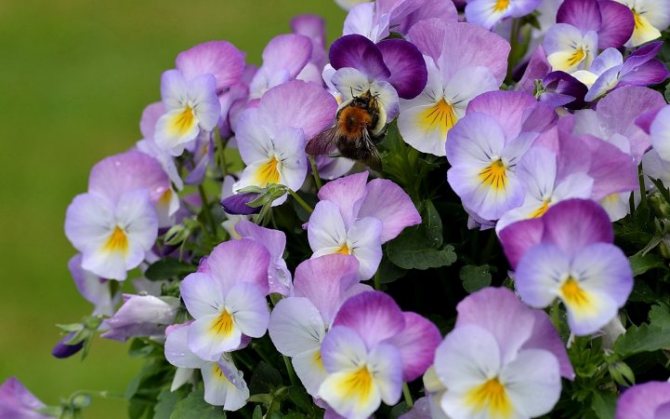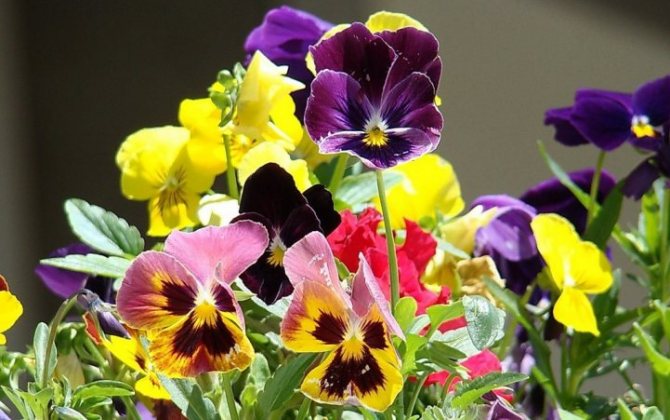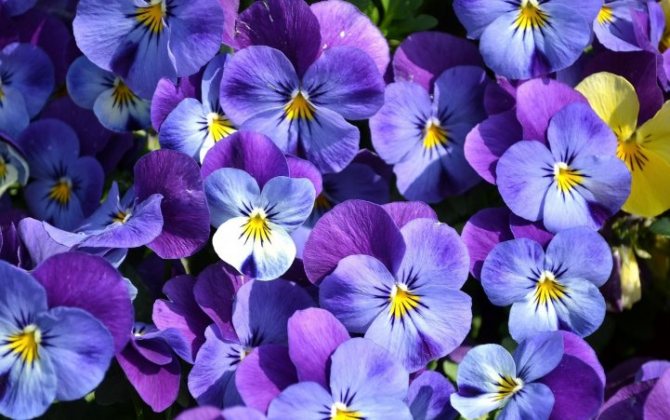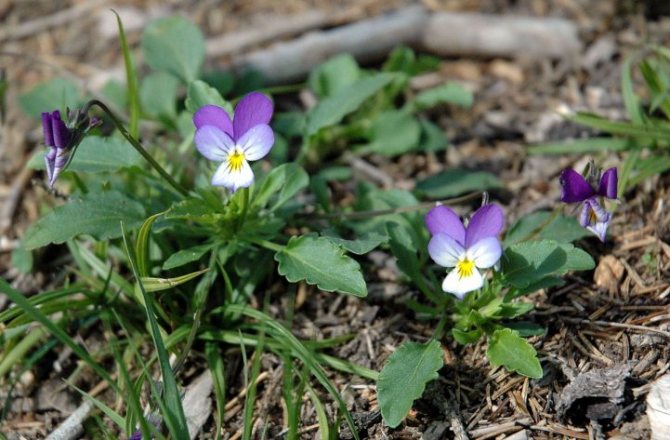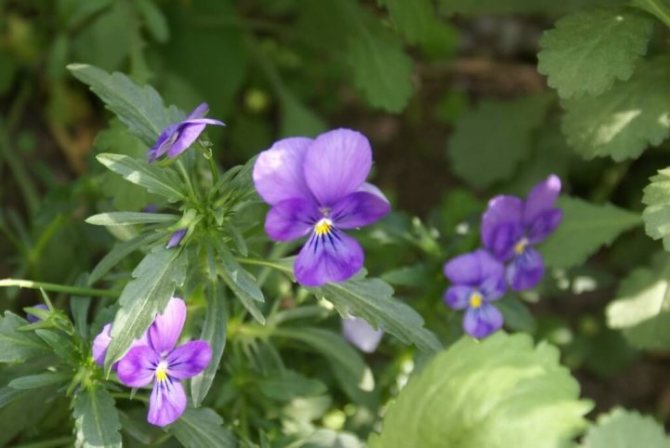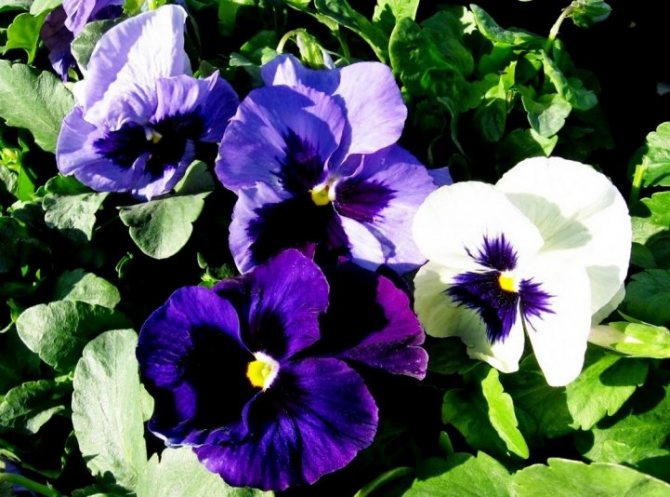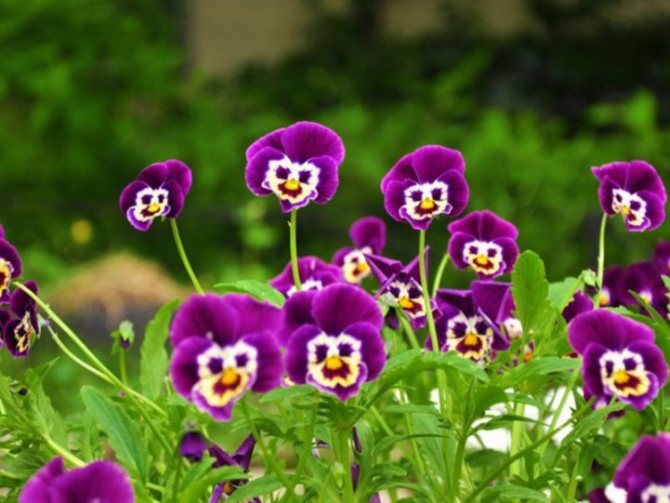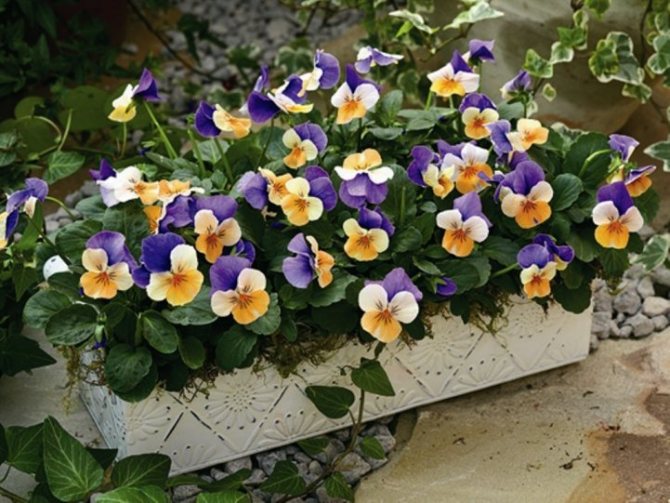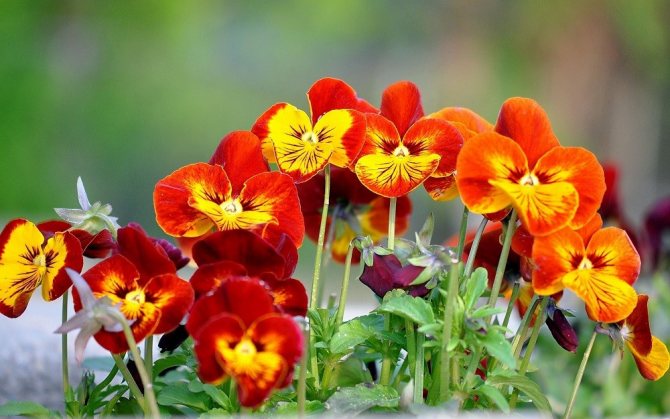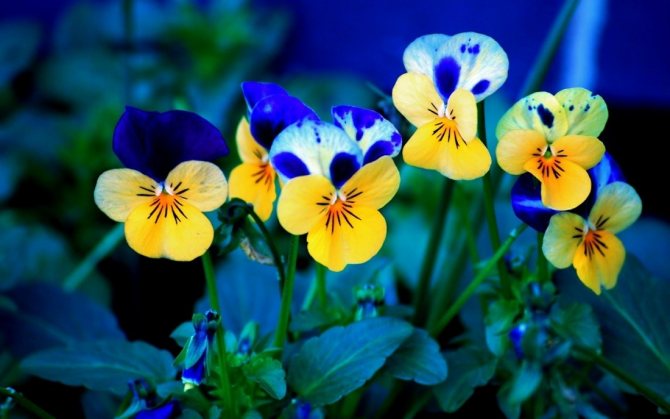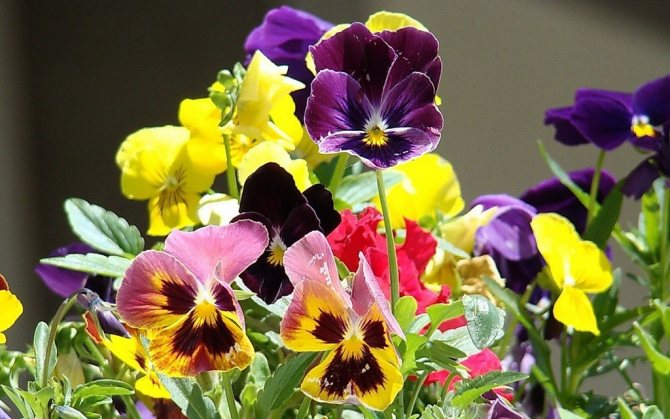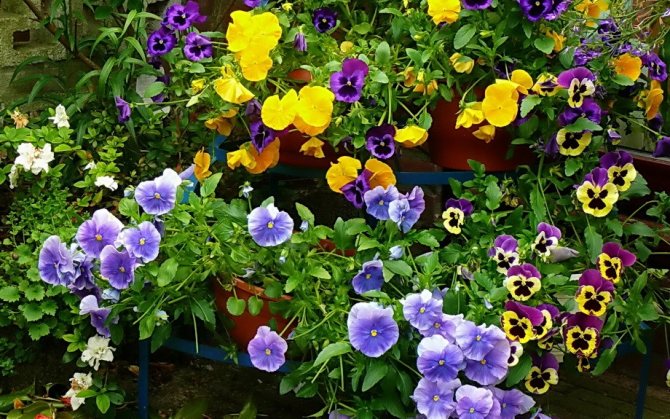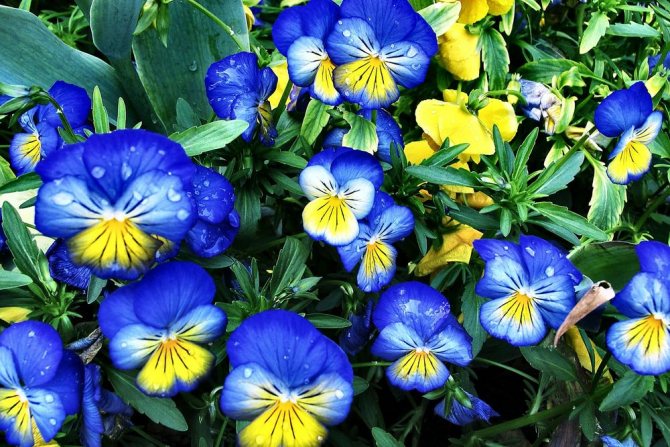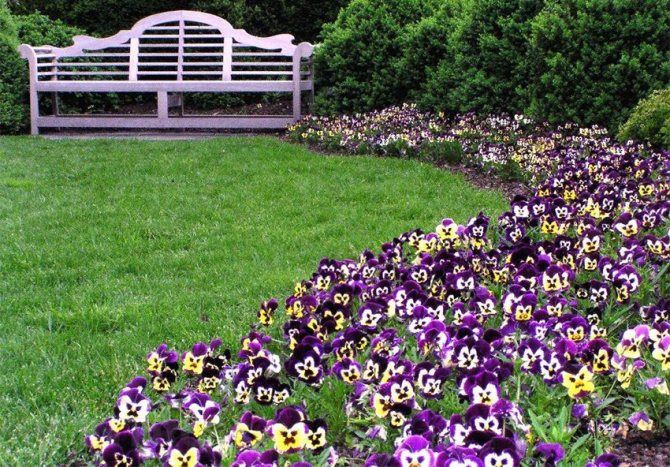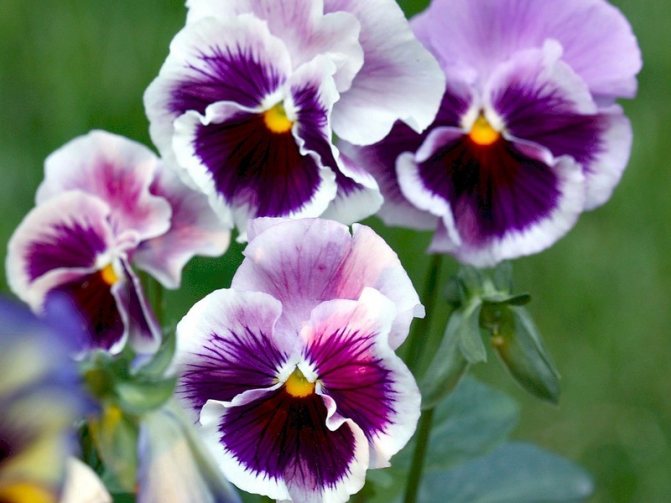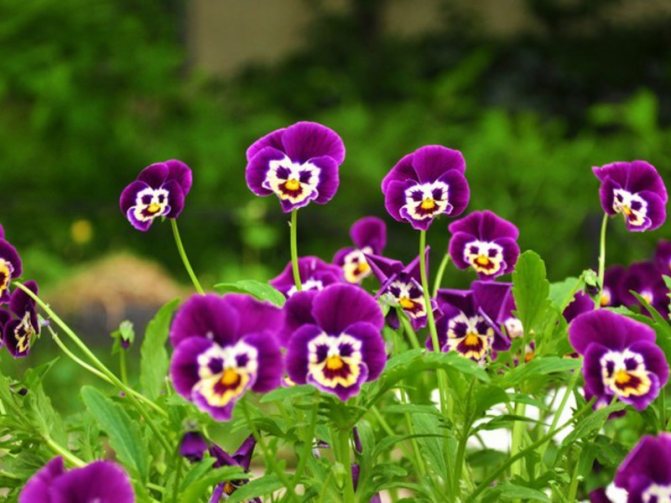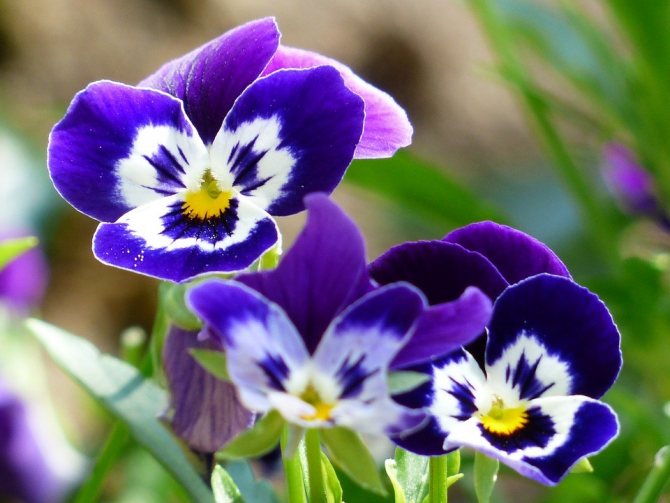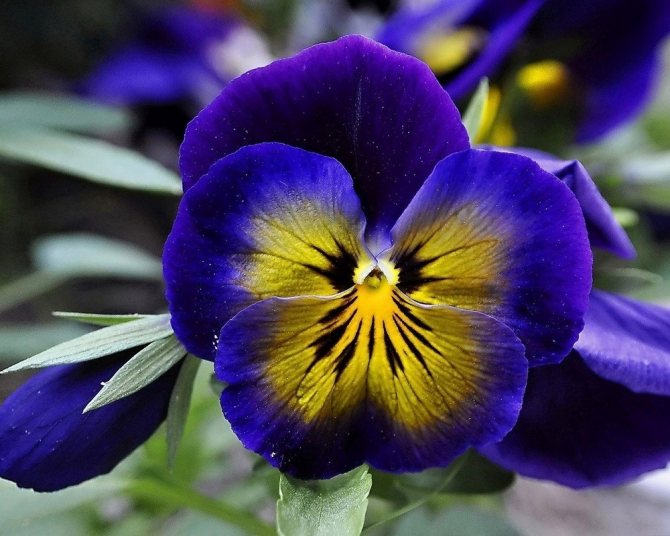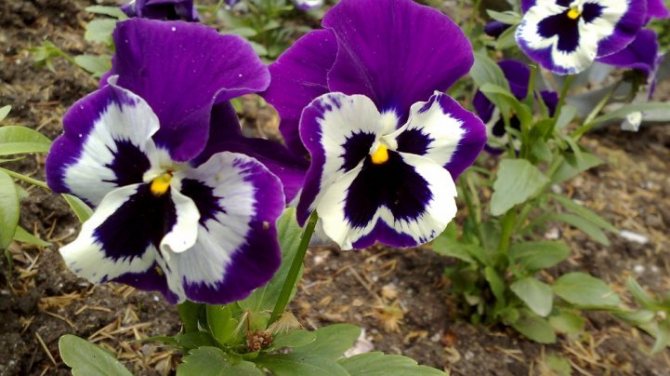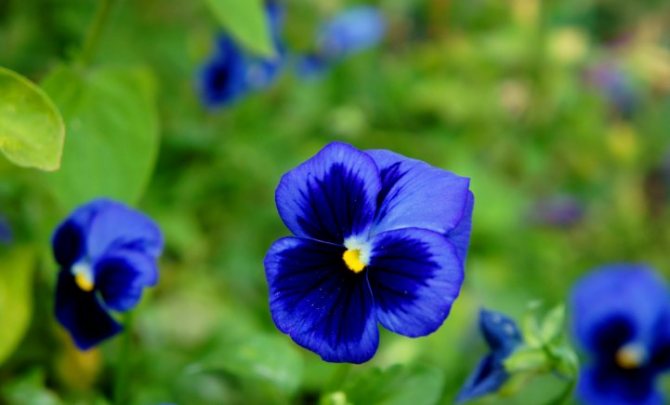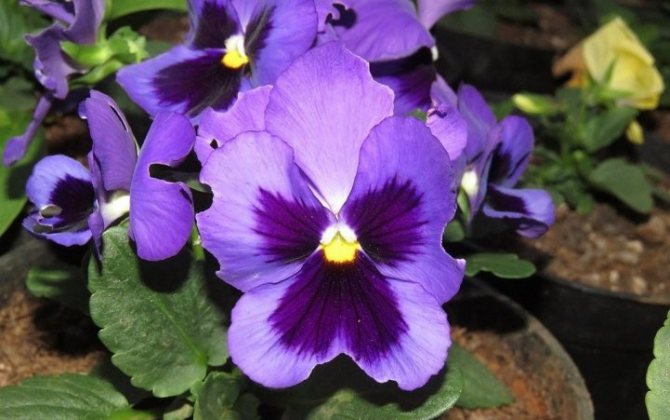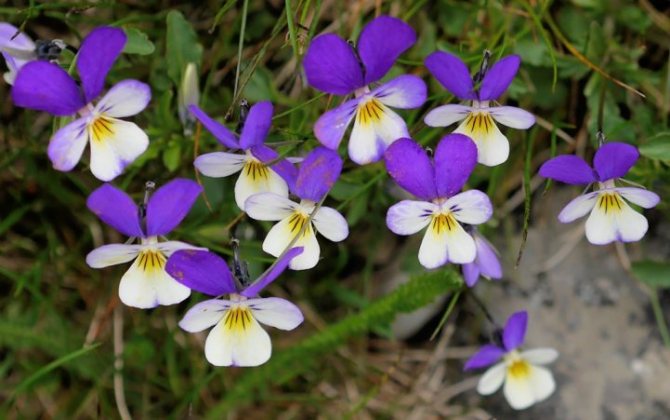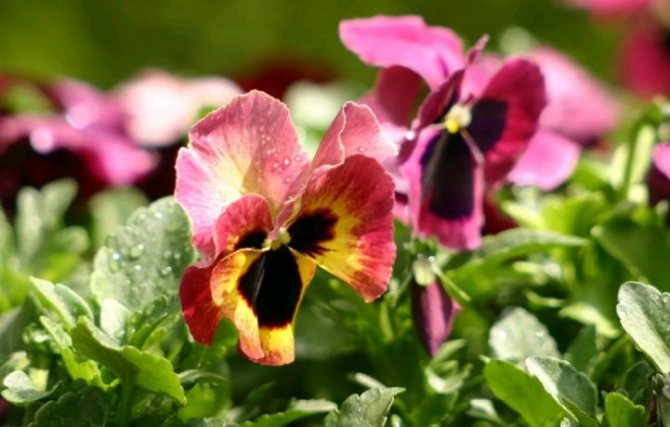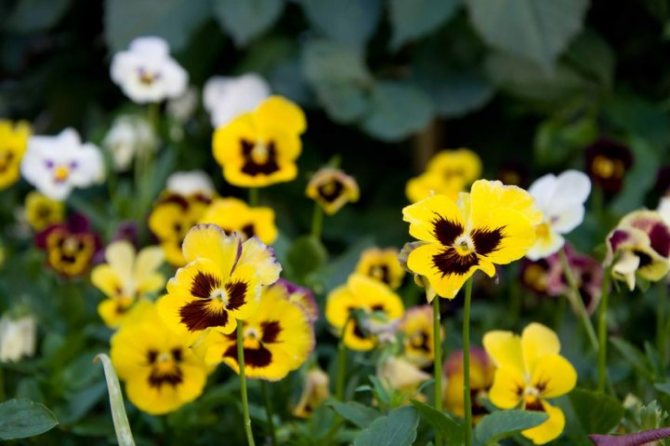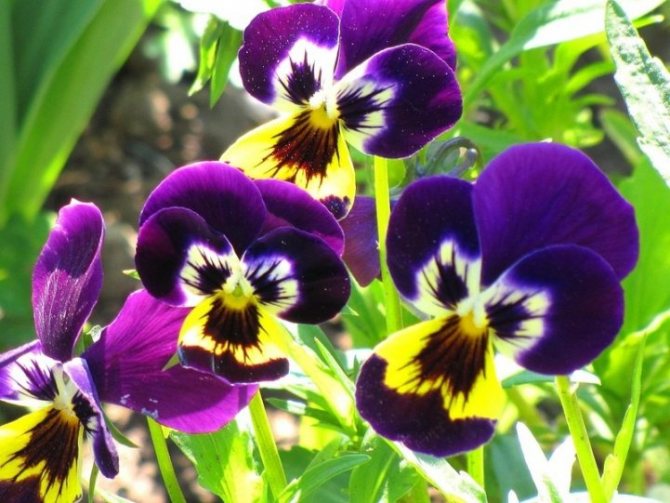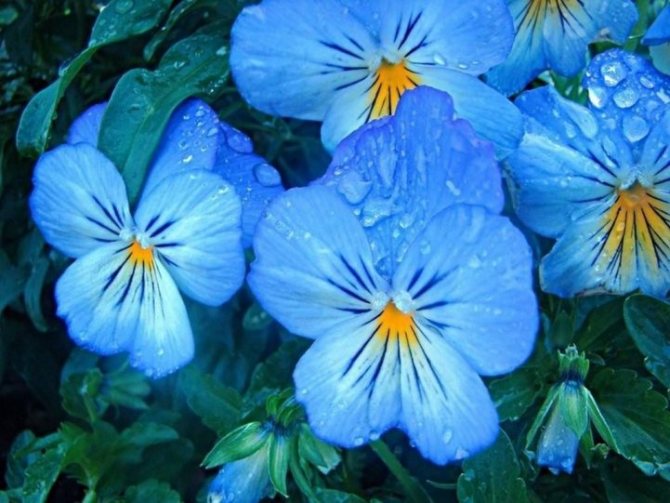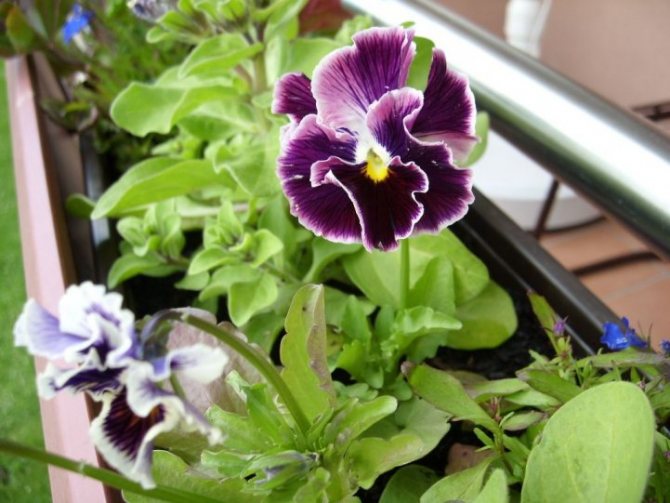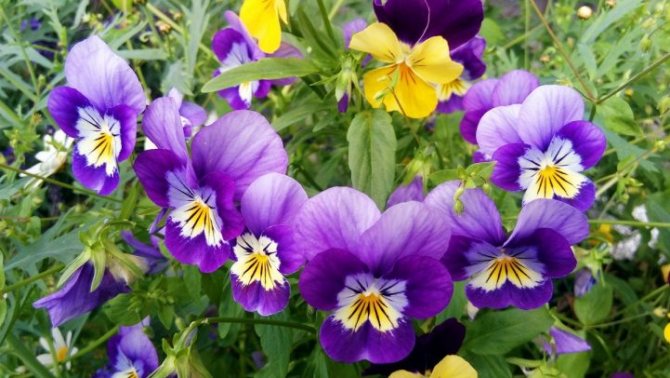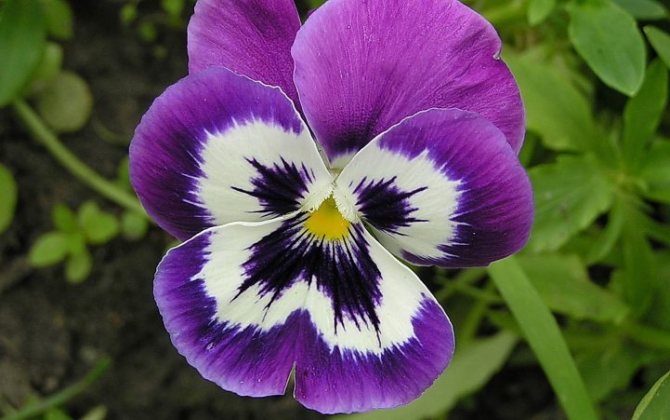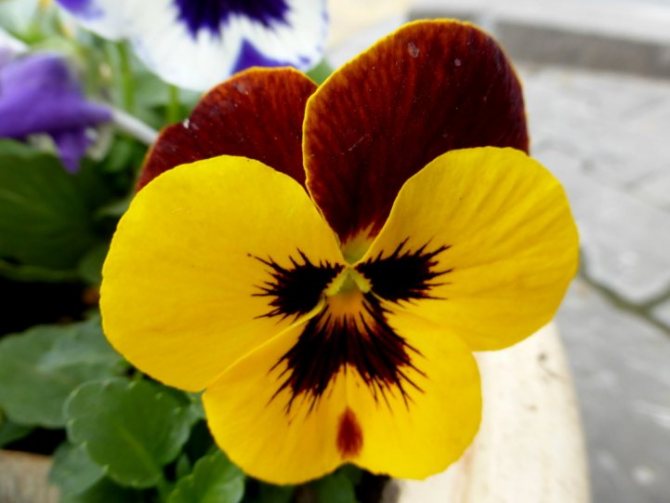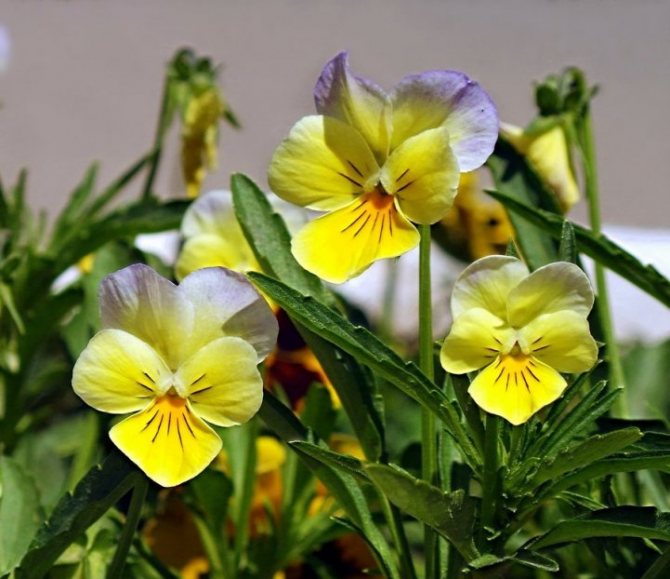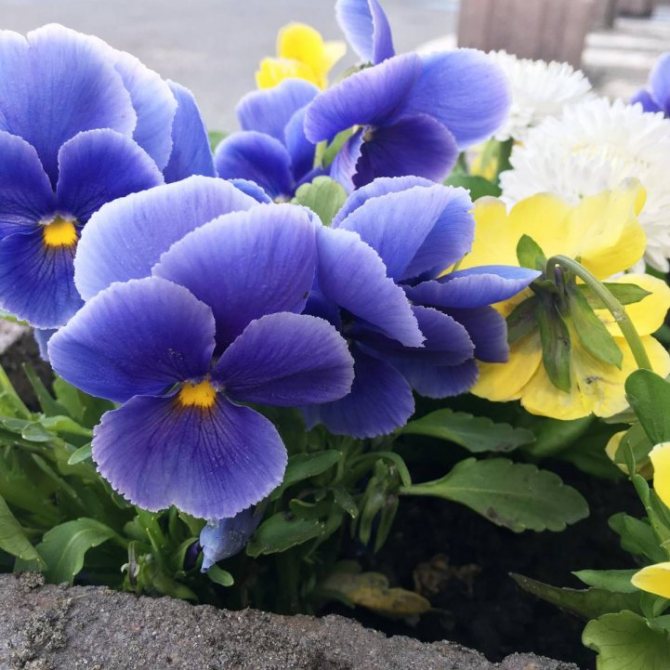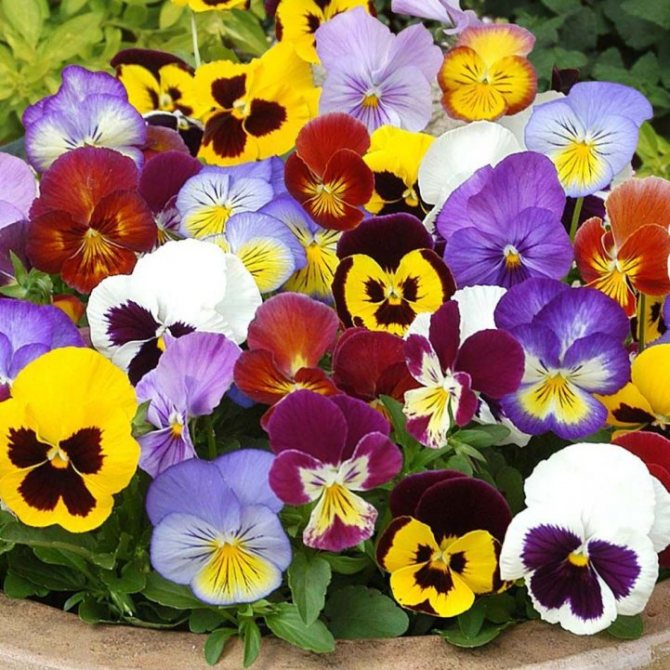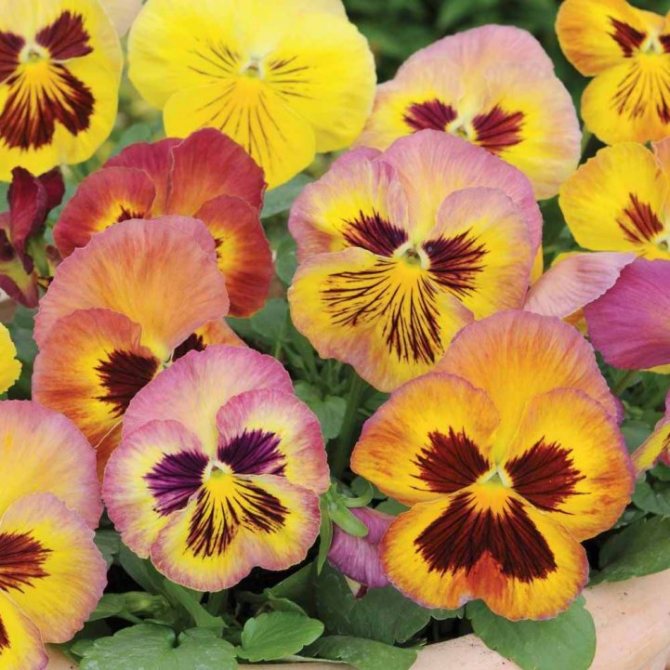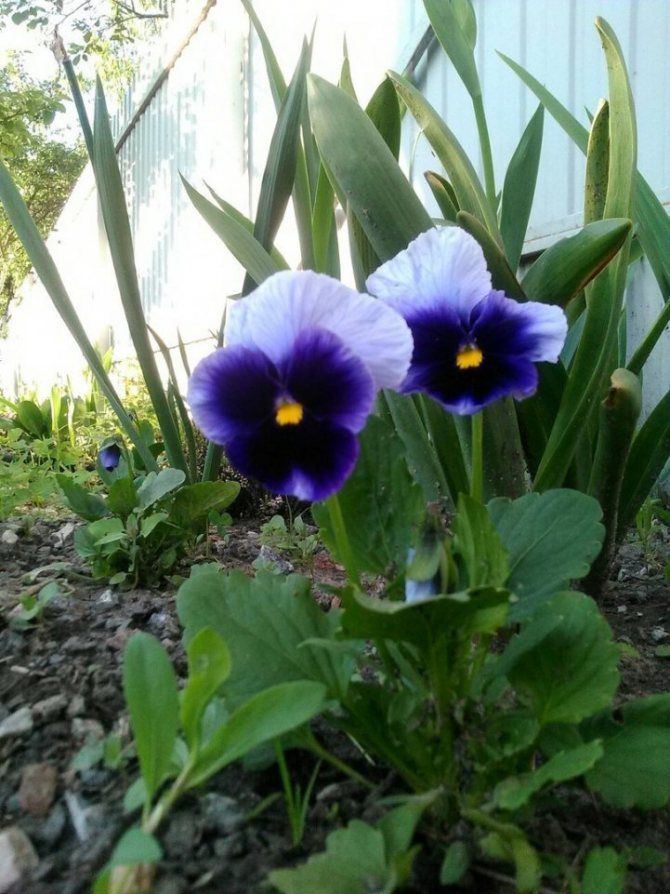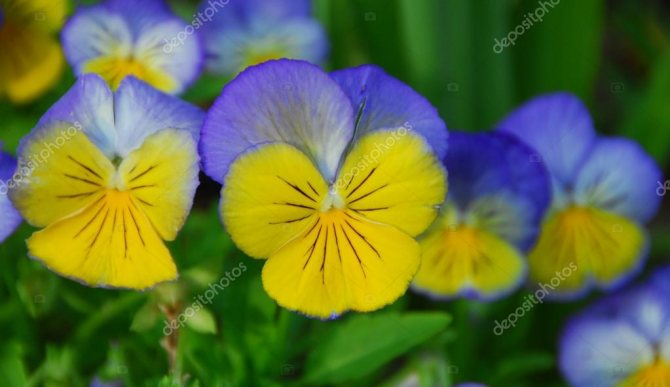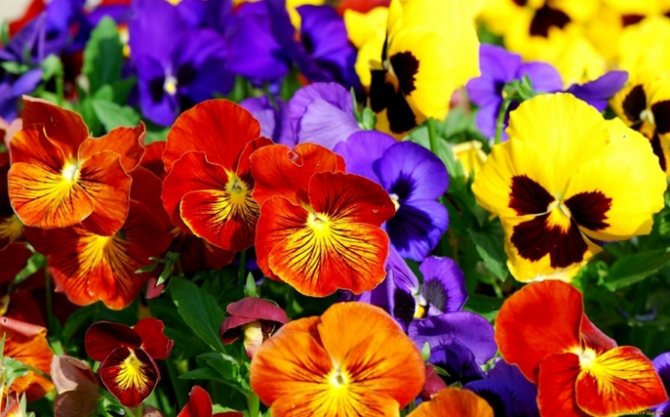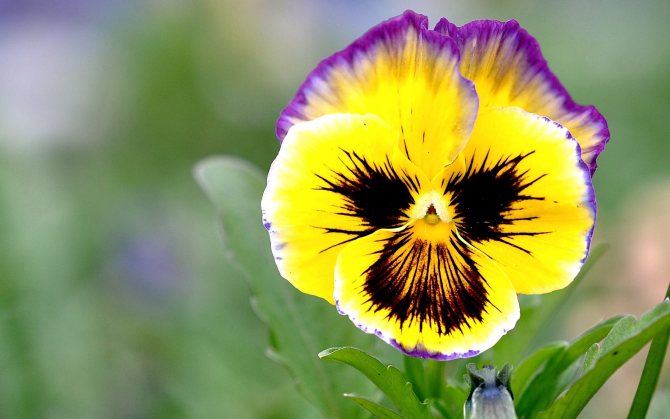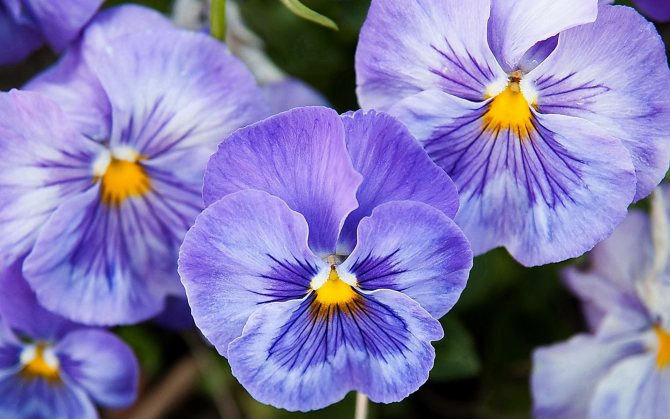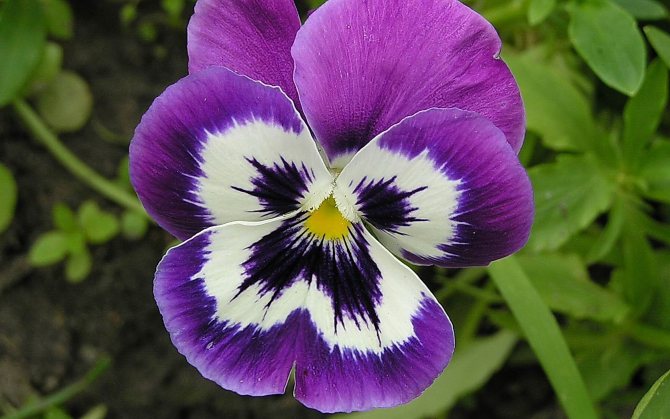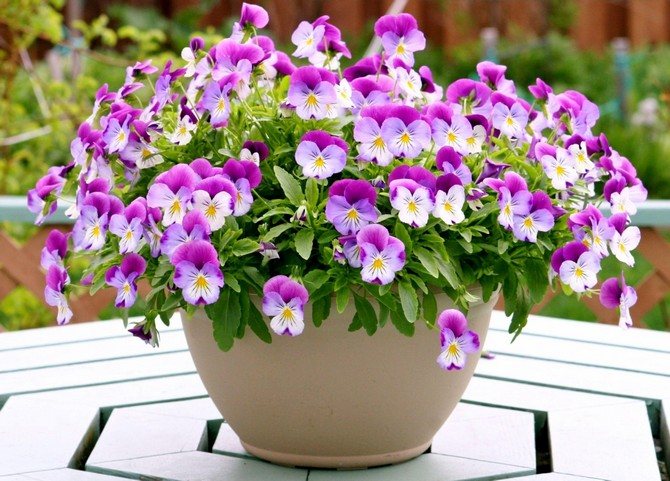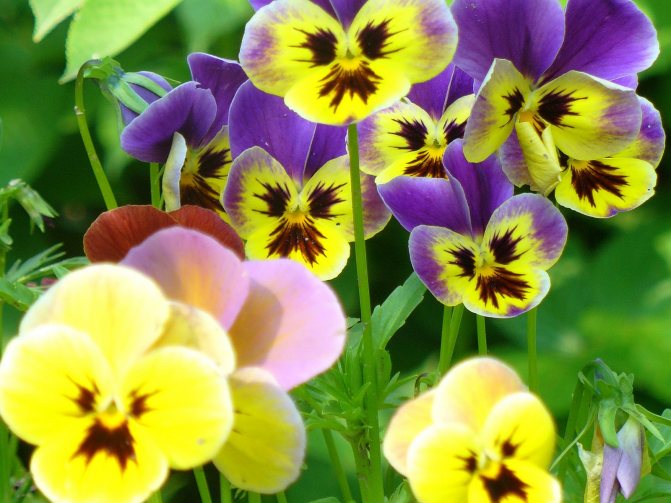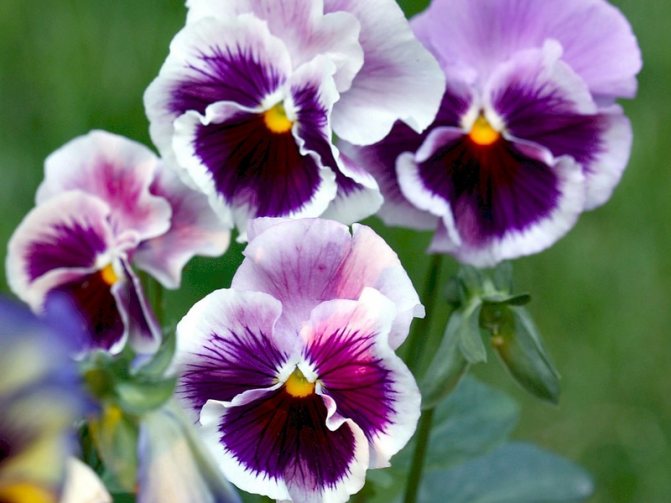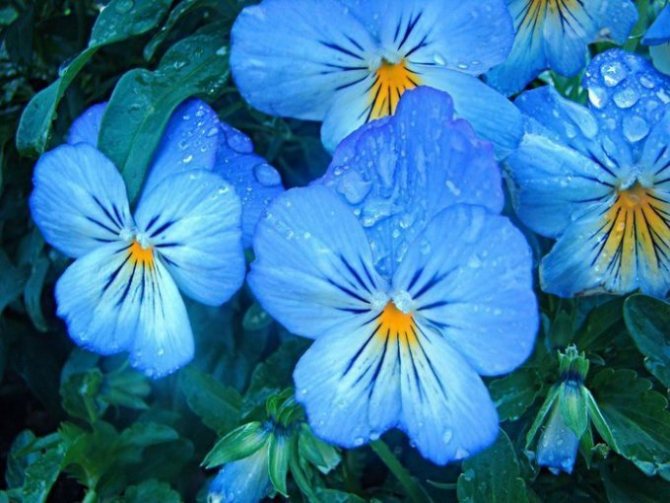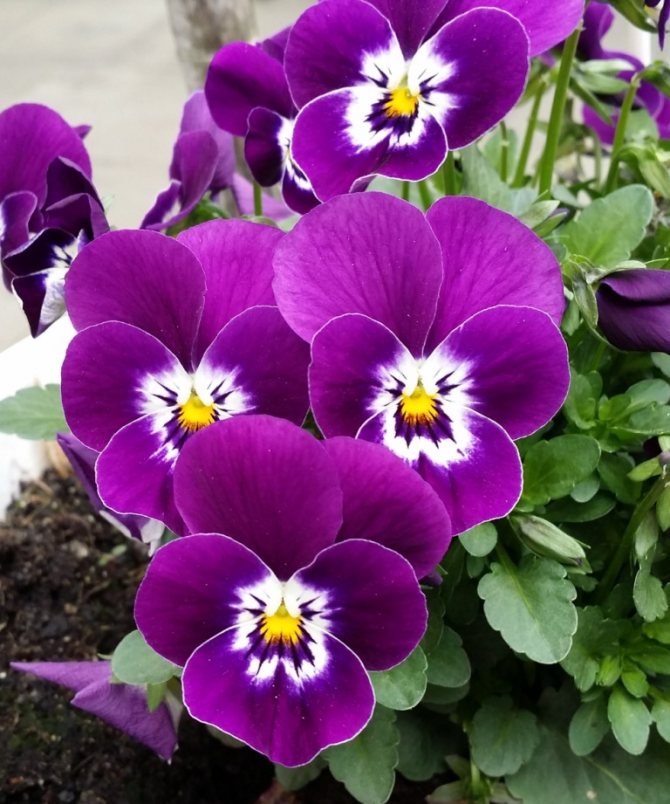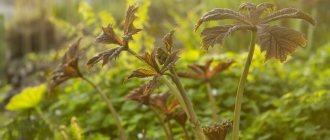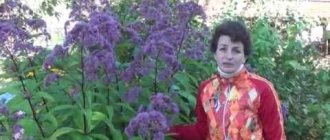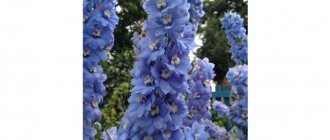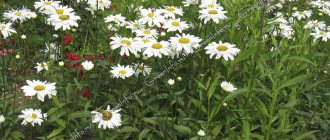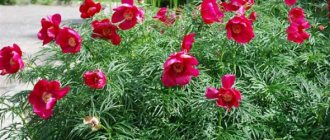Low neat bushes with bright single flowers look attractive. Pansies or Viola tricolor got their name from their unusual colors. Small contrasting spots are clearly visible on rounded petals of the most varied colors. The plant has another name - Ivan da Marya.
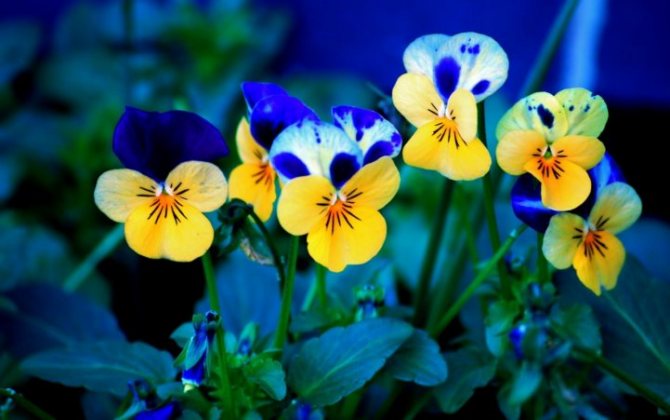
There are about 200 types of Viola in the world. They all have different colors of buds and different properties. The culture belongs to the violet family and has another name - Violet tricolor.
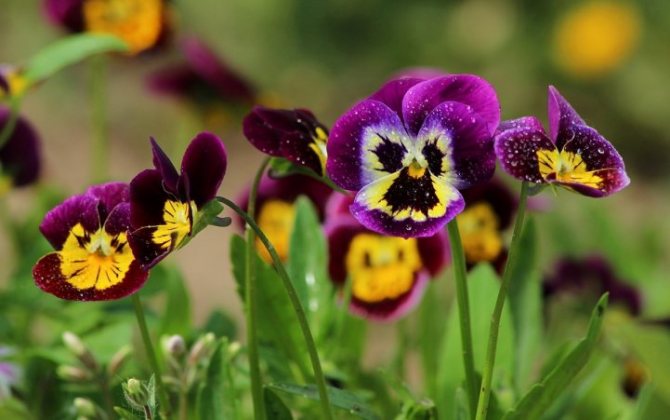

This article describes the peculiarities of planting and caring for Viola. Here you can get acquainted with photos of different types of Pansy flowers and ways to protect the plant from pests and diseases.
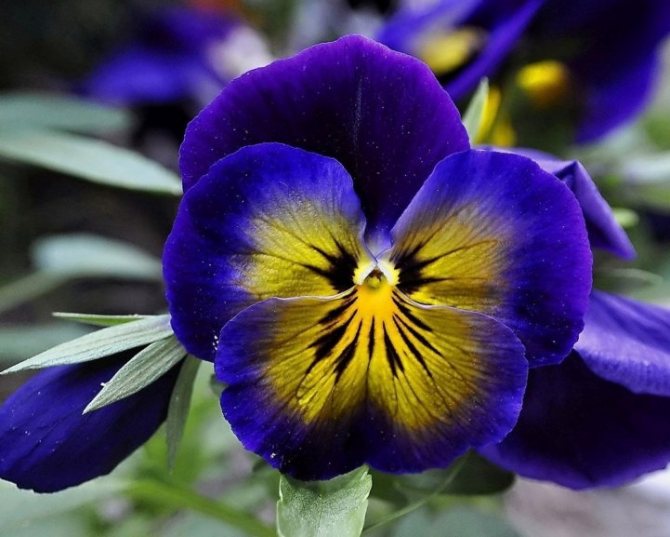

Viola in the garden
Charming viols look great in garden beds.
In the spring, after the snow melts, amazingly bright flowers bloom in the garden - pansies, their petals are painted in bright tones of blue, yellow, purple, burgundy. A characteristic feature of the viola is the contrasting pattern in the form of spots and spurs on the petals, which gives the plant an extraordinary charm.
The first information about growing viola in the garden dates back to the 16th century AD, when the first attempts were made to create new varieties of pansies.
Are pansy annuals or perennials? Answering this question, it should be noted that cultivated varieties are mainly biennials, there is a very small percentage of perennial varieties, there are annual plants among pansies. In total, the Viola genus has up to 500 amazing and diverse plants with bright petals.
Most of the hybrid varieties with large flowers and abundant flowering are biennial plants in which a bush forms in the first year, and after wintering in early spring, charming flowers appear.
Flower farms are trying to sell pansies seedlings in the spring during the period of violent flowering, but when acquiring such plants, it should be remembered that by July your flower beds and boxes will be empty, because after flowering seeds appear on the bushes, after which the two-year-old viola dies.
Agrotechnical cultivation
Pansies are a short flower, rarely a year the height of the bush exceeds 25-30 cm. The flower bush has a compact shape, therefore it is often grown in balcony boxes and pots. Growing in the open field has some features that are worth talking about in more detail.
Landing: prerequisites
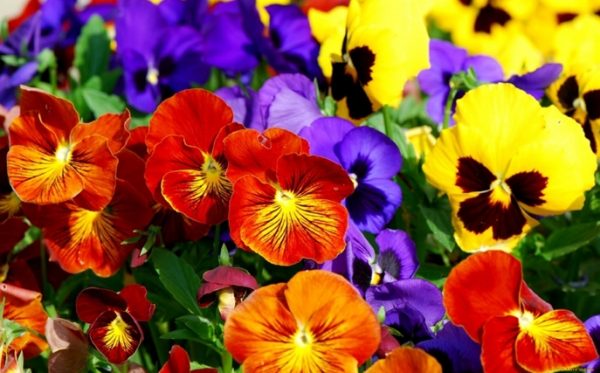

Flowers are striking in their bright colors.
Pansies, or viola, when planted outdoors, require a light location, but plants can adapt to light shade. Direct sunlight has a depressing effect on the plant, so viola grown on the south side can complete flowering faster.
The soil for the culture is prepared in advance, the soil should easily let water through, be fertile - in poor soil, the viola flowers become smaller and become faded.
Blooming viols do not tolerate acidic soils and stagnant water at the roots, therefore, in areas with a high groundwater level, reliable drainage should be made, and only after that young plants should be planted.
Due to the low bush, the viola does not react to the wind, from which it is protected by taller neighbors.
It is allowed to sow pansies in open ground and plant seedlings.
Watering
Pansies cannot look healthy if irrigated. Plants require abundant regular watering, which is especially important in the hot season. To preserve moisture in the soil, planting pansies should be mulched with colored bark or pebbles, which will increase the decorative effect of the bushes during flowering.
Watering flower beds with pansies is necessary only if the topsoil has dried out significantly, because an excess of moisture leads to decay of the plant root system.
Top dressing
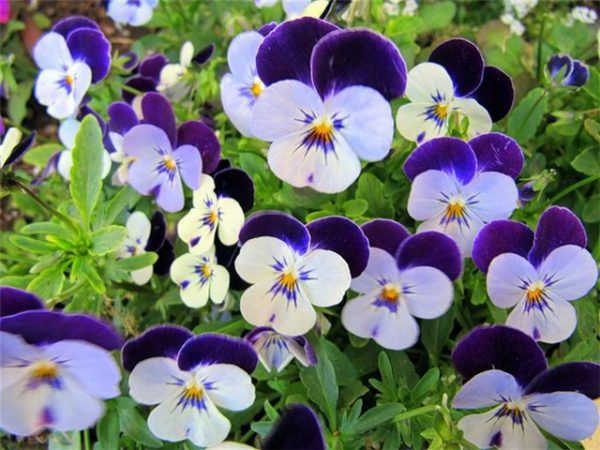

Hybrid viols have amazing flowers of various colors.
After planting the seedlings of pansies in a permanent place, you can begin to make nutritious fertilizing, starting from 10 days after planting the bushes in the ground.
The frequency of dressing is 1 time per 10 days. Attention! The culture does not tolerate fertilization with fresh manure, which is applied directly under the root of the plants. You can alternate the infusion of poultry droppings with nitrofoskoy or fertilizer "Kemira" for flower crops. Top dressing carried out on time has a positive effect on plants - viola flowers acquire huge sizes and bright colors.
Sowing seeds
This is how ripe viola seeds look like.
Pansies are propagated by seeds, with the practice of sowing seeds directly into the ground, as well as growing seedlings.
With the seed method of growing a crop, it is allowed to sow seeds in a prepared bed from spring to mid-summer. The earlier the sowing is carried out, the more likely it is that the first flowers will appear on the bushes by the end of this summer.
Viola seeds are sown in well-dug, fertilized soil after the threat of spring frosts has passed. Seeds are laid out in shallow furrows (up to 1 cm) or in separate holes. After sowing the seeds, it is necessary to thoroughly and carefully moisten the soil, making sure that the seeds are not washed to the surface.
Seedlings appear in 7-10 days, the seedlings begin to grow rapidly, forming lush bushes. In the phase of 3-4 true leaves, young plants dive if the seedlings are too thickened. During the summer, the seedlings will grow a strong bush, which may not produce a single flower until autumn. In winter, a flower bed with pansies should be mulched so that the plants do not freeze. In especially harsh winters, a more powerful shelter is erected over the garden bed.
In spring, young plants bloom very early, as soon as the steg melts. Flowering continues until June, after which the plant begins to form capsules with seeds, the flowers become smaller, appear less and less often.
In July, the seed pods of pansies turn brown, open, shooting small brown seeds in all directions. The next year, new plants can sprout from these seeds by self-sowing in the most remote corners of the garden.
Seedling pansies
Viola saplings cut open.
If you want two-year-old varieties of pansies to bloom this year, you can grow seedlings from seeds. Seeds for seedlings are sown in February in small containers with low sides. Usually, fresh seeds have a high germination rate, by the end of the week there is a massive pecking of young plants.
The most important thing during this period is uniform moistening of crops so that the seedlings receive plenty of moisture. Excessive waterlogging is fraught with decay of weak roots of seedlings, therefore it is necessary to find a middle ground when watering.
The grown viola seedlings must be planted, for which the picking of young plants is carried out.A flower peat pot is the most successful version of a container for planting seedlings, because when transplanted into open ground, the root system of plants will no longer be disturbed.
Seedlings are planted in the ground in May, and the first flowers on the largest bushes will appear in August. You should not wait in the first year of the exuberant flowering of two-year-old viols, the plants will present lush flowers next spring.
Flower care
Viola tricolor is a light-loving plant. However, the hot summer sun can cause shrubs to burn out. Therefore, in hot weather, in open areas, you will have to come up with artificial shading.
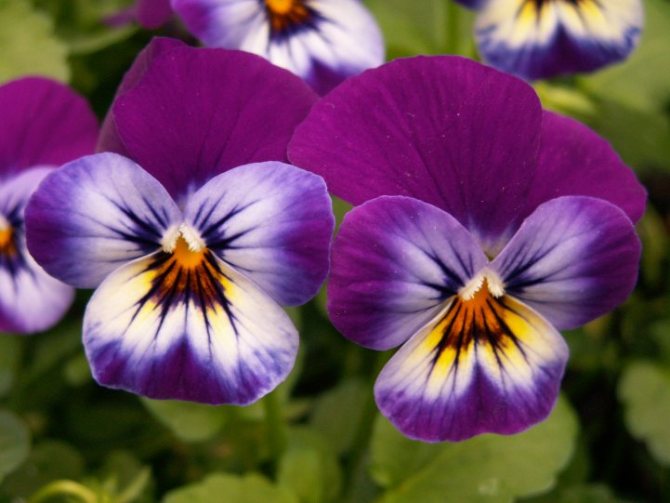

Violet is a fairly cold-resistant culture. It can withstand temperatures down to +3 - + 5C. For normal development and abundant flowering, Viola needs temperatures from 10 to 25C.
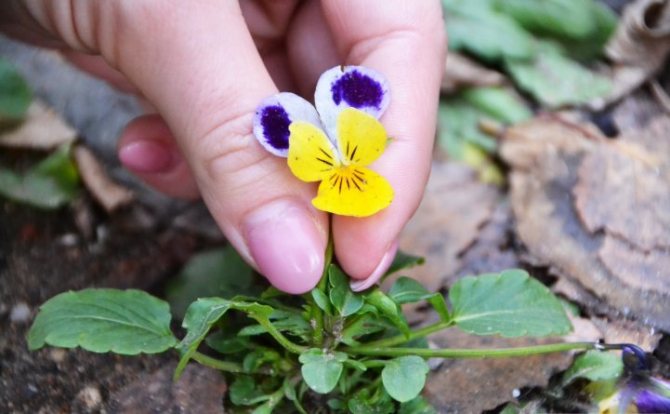

Water the plants sparingly. An excess of moisture will lead to diseases, and a lack of moisture will lead to drying out and extinction of flowering.
Faded flowers must be plucked to stimulate the emergence of new buds.
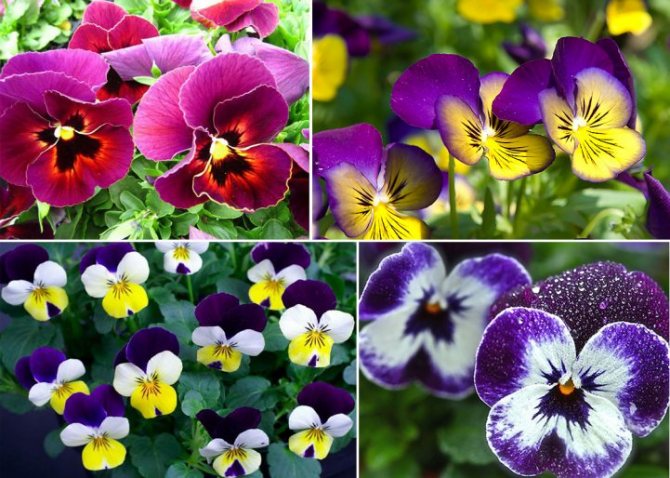

Top dressing should be done once a month. 2 weeks after planting, the first top dressing is applied to a permanent place. Fertilizers need to be introduced at the root, trying not to get on the leaves. The best nutrient mixtures for these plants are complex mineral fertilizers. Fresh manure does not suit them.
Perennial Pansy flowers need regular rejuvenation every 3 years. For this, cuttings are used.
For the winter, perennials are covered with a layer of leaves, and in the spring they are opened at stable temperatures above zero.
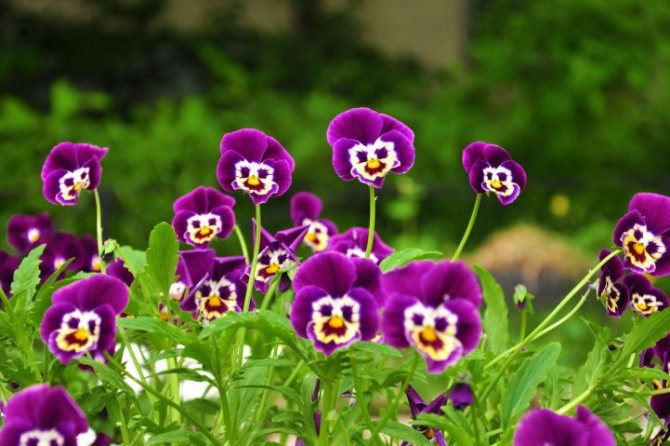

Varieties and varieties
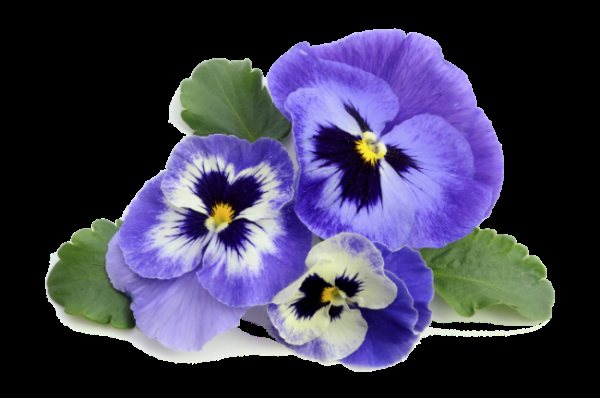

Viola flowers can be up to 10 cm in diameter.
Tricolor Viola (Viola tricolor) - represents wild species that bloom on small bushes, up to 16 cm high, from spring to autumn. Flowers are painted in blue-violet colors, there are varieties with white and yellow flowers. In nature, the plant loves to settle in meadow wastelands, forest edges and near ravines.
Horned Viola (Viola cornuta) - refers to perennial plants that require reliable shelter in the winter. The flowers are brightly colored from white to all shades of purple purple. Large flowers reach 6 cm in diameter.
Viola Wittrockiana are garden hybrids that are most popular when grown in the garden. The plant is quite tall - the bush reaches a height of up to 30 cm.The bright flowers have contrasting spots and stains on the petals, up to 10 cm in diameter.
Description of common species and varieties
The plant has several names. Violet (Violaceae) belongs to the genus of plants in the violet family. Viola (Viola) is called a flower in Latin. Pansies, or tricolor violet, is a perennial plant, the species of which belongs to the genus violet.
The viola flower is found in nature as an annual and perennial plant. Viola can be found in the form of a small shrub, but rarely. On average, the plant grows from 15 to 30 cm in height.
Viola became famous in Russia at the end of the 18th century. She was brought to St. Petersburg from Altai and later received the name Altai violet... The most famous and popular types and varieties of flowers:
At the beginning of the nineteenth century, this plant was widely studied, and the famous Swedish botanist Veit Wittrock bred the most popular to date, a new hybrid species of violets by crossing three colors: violets yellow, tricolor and Altai. This hybrid type of plant was named the violet wittrock and currently has several hundred varieties.
The hybrid is a dense, branched bush, reaching a height of 30 cm.The flowers grow large, up to 11 cm.They are irregular in shape and have many different shades. There are almost no monochromatic petals in this species. Many varieties of viola are combined in a series for easy classification:
- Swiss giants are large-flowered species with a flower 7 cm in diameter. The plant is not tall, 25 cm. It blooms until the first frost.
- Rococo - the flowers of the plant have a corrugated edge, they are of unusual lilac, orange, lilac shades. Cultivated as an annual and biennial crop. When grown from seed by sowing in open ground for the next year, it blooms from May to October.
- Bambini is a plant with an average height of 20 cm. Differs in color and the obligatory presence of a white or beige "butterfly" in the center of the flower.
Viola horned - perennial... It got its name from the presence of a spur on the back of the flower, similar to a horn. The bush is low, up to 25 cm. The flowers are medium-sized, 4−5 cm. The petals of the plant are painted in bright lemon, purple, lilac and sky-blue colors. The horned viola is distinguished by darkening or lightening in the center of the petals.
Perennial horned violet - unpretentious plant... It tolerates frost and is not afraid of snow cover, does not require additional shelter.
There are varieties that bloom three weeks after germination from winter dormancy.
The tricolor violet, or pansies, differ from other varieties in their colors - the famous tricolor. The upper petals are dark purple and the lower ones are bright yellow. Closer to the center of the flower on the petals dark stripes, and the edges of the petals have a velvety border.
Violet ampelous became widespread due to its shape. A plant with narrow leaves resembles a ball. There are a lot of flowers in ampel varieties. The size of the flower does not exceed 4 cm, and they are usually painted in one color. Can be found ampel viola with variegated petals.
Bushy ampel violet grows up to half a meter. Shoots, when flowers appear, begin to hang down in a cascade. Flowering lasts until the first frost.
Pansies, cultivation
The content of the article :
The cultivation of flowers with this poetic name is widespread in our gardens, both in flower beds and in flower pots and containers.
Pansies (another name - viola) in ancient times were credited with a magical property - to bewitch love. It was believed that one has only to splash the juice of this plant on the eyelids of a sleeping person, then wait for his awakening and the one whom he sees first and becomes the object of his adoration.
The French and Poles usually present these flowers to their loved ones during the upcoming long separation.
They are perennials and are often grown as biennials or annuals.
Together with other annuals, such as purslane or nasturtium, they perfectly decorate any garden, terrace, balcony.
Growing features
For the successful cultivation of violets, open sunny areas should be preferred. If you sow seeds in the ground, then flowering in the same year will not work. Beautiful greenery will appear, and the buds will bloom only next year. Seeds are then harvested from them.
The area where the pansy flower will grow must be warmed up and illuminated by the sun for at least 6 hours a day. Fresh manure as a fertilizer for viols is contraindicated. During the cultivation process, it is recommended to apply top dressing every week to get lush buds and abundant flowering. The fertilizer should contain:
It is recommended to water the flowers 1-2 times a week, depending on the weather conditions. After watering, the soil should be loosened, which will help the plants tolerate well even the abnormal heat in summer. Lack of moisture will negatively affect the appearance of pansies. They will appear sprawled on the ground.
Perennials or annuals?
Pansies can be grown as annuals and perennials. It all depends on the climatic conditions in which the plants are grown and the labor that you are willing to put in. These flowers are quite frost-hardy, but even in central Russia they are not always able to survive the cold winter. Particularly vulnerable are plants that were planted late, did not bloom well and left weakened before winter.
Viola does not tolerate wintering well in winters with little snow; spring thaws with subsequent night frosts are especially dangerous for flowers.
In order for the viola not to freeze, it is necessary to avoid low damp places for planting, cover the flowers with covering material for the winter, and in winter carry out snow retention in a flower bed with pansies.
In order for the viola to bloom earlier, it is better to close the flower bed with foil in early spring. Growing an annual viola is a more predictable process.
Watering and feeding rules
The main requirement for good growth and flowering of violets is timely watering. The root system of flowers develops in the soil at a depth of 15-20 cm, therefore, in dry summers, it should be watered more often, but only when the top layer dries up. Violet has enough natural moisture, which comes with precipitation.
Timely removal of faded buds will facilitate the development of new ones. So the grower will have flowering plants all season. Dry leaves should also be removed.
You can fertilize the bushes once a month. Purchase fertilizers for flowering plants with the least amount of nitrogen.
For the winter, the violet is covered with spruce branches or leaves.
Viola varieties
Numerous varieties of these flowers are hybrids of several types of violets. All varieties are widely used in floriculture to create borders, flowering carpets, flower beds, flower beds, as well as to decorate windows and balconies.
Viola can be compact or spreading bushes. Viols are widespread throughout the globe. The most common groups among our florists are as follows:
- Erfurt early, himalis winter, Swiss large-flowered (Roggli), profusely blooming trimardo.
Pansies have an incredible variety of colors and colors, the most popular is the tricolor viola - the top of the petals is purple, the middle petals are yellow and the lower petals are light yellow or white.
Plant characteristic
Growing pansies
The plant grows in small shrubs that grow on their own with proper care. There are a large number of viola varieties, which are characterized by frost resistance, large flowers, and vitality.
The shoots of the plant are straight or creeping, the leaves resemble the shape of a heart, the edges are slightly corrugated. The flowers are single with bright petals. The peculiarity of the viola is its lush bloom.
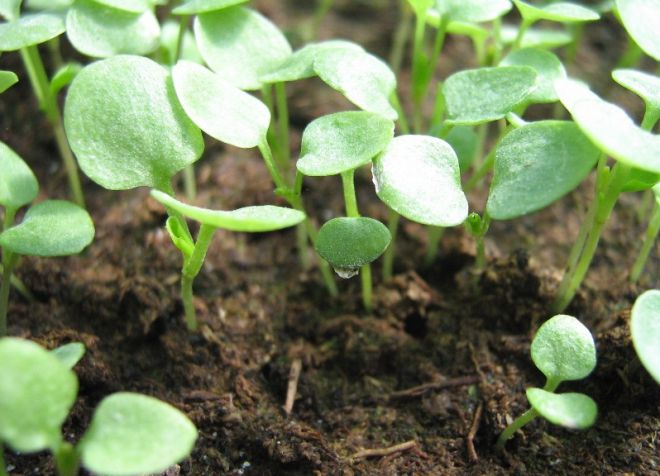

Leaves resemble a heart shape
Chemical composition:
- Insulin;
- Ascorbic acid;
- Vitanim S;
- Essential oil;
- Tannin;
- Violaemetin alkaloid;
- Salicylic acid;
- Polysaccharides.
The rich chemical composition of flowers explains why they are widely used in folk medicine and pharmacology.
Landing conditions
Pansies are thermophilic plants. They should be grown in sunny or slightly shaded areas. In partial shade, their flowers become small, the plant itself grows for a long time.
But in a sunny place, the plant has large, bright flowers. Plants do not tolerate lowlands and damp places, spring stagnation of water rather poorly. Loamy, fertile, moist, neutral soils are suitable for pansies.
Growing methods
You can grow these flowers from seeds, planting them directly in open ground, or grow seedlings from seeds.
In addition, it is possible to self-sow pansies in the spring in the place where they were planted last year.
At the same time, the flowers are pollinated, their species differences are lost, the color and size of the flower change.
These flowers are cross-pollinated plants, when planting, different varieties must be planted at a distance from each other in order to maintain the purity of the variety.
To collect seeds from your flowers in the country, you need to select strong specimens, wait for the seed pods to turn yellow and collect the seeds before the pods crack and the seeds spill out onto the ground.
At the same time, it is possible to prepare seeds of exactly those varieties of flowers and colors that you like. The seeds are very small - there are almost a thousand seeds in one gram.
Growing from seeds in the open field
Seeds are planted in open ground in June - July, and pansies will not bloom this year. The flowers will bloom profusely next year in early spring.
Seeds are sown in rows in a nursery - a special bed with well-prepared soil. After the emergence of shoots, they dive, that is, they are transplanted with pinching of the central root by one third for better root formation.
It is done in the presence of two true leaves and transplanted to a permanent place within 25 by 25 centimeters. The plant should develop well over the summer, but not bloom.
Growing seedlings
Seeds are sown in early March in shallow containers with a drainage hole. The soil for seedlings is shed with potassium permanganate per day. The seeds are laid out, moistened with a sprayer, covered with glass or the boxes with seedlings are placed in a plastic bag and placed in a warm, dark place.
When the sprouts appear, we transfer them to the windowsill, making sure not to steam under the film or glass. Next, we act in the same way as with sprouts in the open field - we dive and then transplant them into separate cups.
At the end of April, you need to harden - take the seedlings out into the street or balcony. In open ground, seedlings are planted depending on the weather in April - early May, and in a month the viola will delight you with abundant flowering.
Propagation by cuttings
Pansies, along with seeds, are also propagated by green cuttings. When the bushes have been growing for more than two years, they can grow strongly, flowering becomes less abundant.
In order to rejuvenate the plant and propagate it, cuttings are used.
From May to July, in several stages, the most beautiful specimens are chosen, the buds are removed, young end shoots with 2-3 nodes are cut off and planted tightly to each other in the shade in moist soil.
Cover with a jar or paper dipped in water. Cuttings grow well when planted under the crown of a tree. In the fall, after the cuttings have grown well, you can transplant them to your permanent place. Plant care. For the winter, plants are mulched. Standard care: weeding, watering, loosening, top dressing. For long-term flowering, faded flowers are removed.
Bloom
Flowering begins in April and lasts until the onset of frost.
Because of the love of the sun, pansies on the sunny side are always larger and brighter in color, but they will fade faster. Pansies, which are grown as biennial plants, are recommended to be cut by cuttings.
Plants grown from summer crops in the previous year or grown from cuttings bloom more abundantly and have larger flower sizes than annual flowers.
Watering. Water at the root, abundantly and regularly. Fertilizers, top dressing. These flowers love fertilizers containing potassium, phosphorus, nitrogen, and trace elements. The first feeding is carried out at the beginning of butanization. Diseases, pests. The plant is affected by the following diseases and pests: powdery mildew, leaf spot, root nematode, black leg, aphid.
Useful Tips
Growing in areas with a cold climate requires one important procedure - the plants should be dug up for the winter, transferred to a greenhouse. For other regions, it is quite enough to cover the plants well with sawdust, covering material.Pansies can be combined with other biennials and perennials such as mignonette.
Sowing seeds in open ground
In June, the seeds of Pansy flowers are sown in a prepared place in the flower bed. It is not worth deepening them much, no more than 1-1.5 cm. From above it is necessary to sprinkle with a layer of earth and lightly tamp.
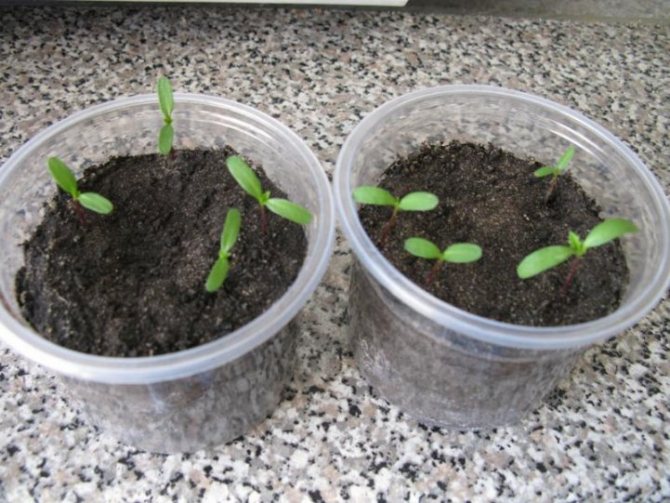

We recommend reading:
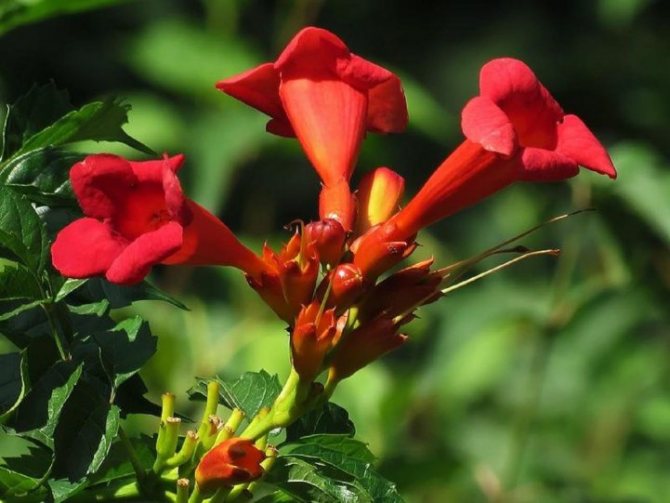

Campsis - planting, care, application in design and advice on how to grow a plant outdoors correctly (120 photos)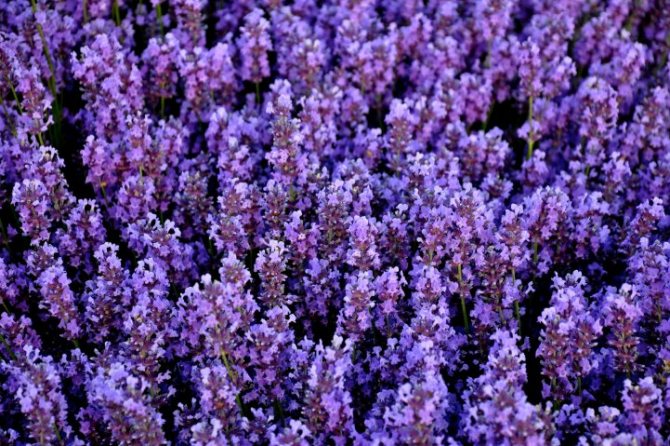

Lavender: application ideas, growing rules and breeding features (105 photos + video)
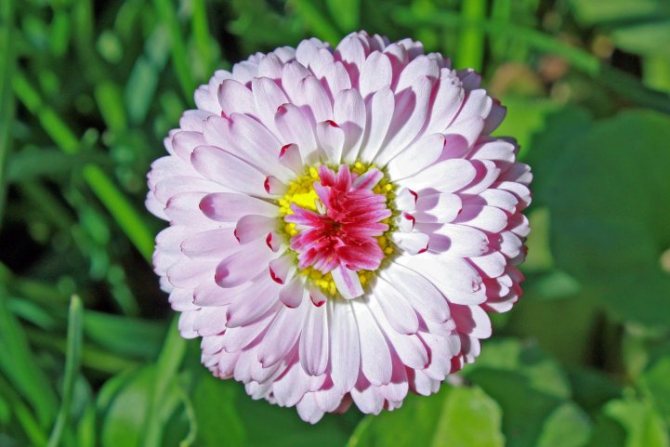

Perennial daisy: the rules of planting and care in the open field. Features of the use of daisies in decorating the garden (145 photos and videos)
After the appearance of 2 true leaves at the seedlings, they dive. At the same time, the roots of the seedlings need to be shortened to stimulate the development of new roots. The distance between seedlings should be 10-25 cm, depending on the variety.
Plants planted in this way for the winter should be covered with a layer of foliage or spruce branches. They will begin flowering next year, with the onset of warmth.
Botanical description
Tricolor violet - a flower with erect, branched, thin stems, 15-20 centimeters high... The leaves are arranged alternately. The shape is slightly round and heart-shaped. They are adjoined by large lyre stipules. The leaves on the stems are sessile, and the lower ones are petiolar.
The flowers are rather large, single, irregular in shape, they open on elongated pedicels. They reach 3-4 centimeters in diameter. The corolla forms five petals that are not alike in shape. The lower petal is yellow or white. He's bigger than the rest. The two upper petals are purple-blue or dark purple. And the side ones are often light purple in color.
Which plants does it belong to: annual or perennial?
Pansies are a perennial plant.... Most often, amateur gardeners purchase a one-year or two-year flower in stores. The question arises why they do not take a perennial violet. The thing is that over time, a beautiful flower loses its beauty. After three years, the plant grows old. The buds become small, and then do not form at all.
Origin story
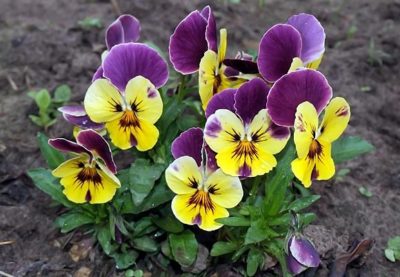

It is not known exactly when and under what circumstances the pansies appeared. Whole legends have been invented about the origin of the tricolor violet, but which of them are true and which are not, is also unclear. Here is one such legend:
Once, the goddess Venus wanted to swim away from human eyes. She discovered a secret corner in a distant grotto. While bathing, the goddess suddenly heard a rustle. Turning, Venus noticed several eyes of curious mortals. She got very angry and decided to punish these people for such insolence. But Venus was unable to punish the curious, so she turned to Zeus, who turned them into pansies.
We recommend watching a video about the legend of the origin of Pansies:
What does a viola look like?
Pansies have a thin stem with rounded leaves and single flowers... In height, the stem can reach up to 30 centimeters. Inside, it is triangular, branched, hollow or erect. Sometimes, several creeping stems extend from one root.
Single buds with five petals, which, in turn, are located on a triangular peduncle with two bracts near the flower itself. The sepals below are larger than the upper ones. The predominant colors in the color are blue, violet and various shades of these colors. The plant has five stamens pressed against the pistil. They are in contact with anthers with short stamen filaments.
The leaves of the pansies are petioled, they are glabrous or sparsely hairy along the veins... The lower leaves are ovoid in shape. The petioles are elongated. The upper leaves look different. Their shape is oblong lanceolate. The petioles on them are small.Each leaf has two stipules.
The root of the flower is thin, with stems and little branches. It is brown in color. It enters the ground almost vertically.
Description and varieties of flowers with photos
Pansies are a typical perennial, grown by gardeners as a biennial or annual. Flowering begins soon after the snow melts and the soil thaws, continuing throughout the first half of summer. Flowers with a diameter of 6 to 10 centimeters grow from the axils of delicate, light green oval-shaped leaves with a crenate or serrated edge.
The color of the flowers is varied. Initially, varieties of lilac, yellow, white and blue shades were bred. Later, reddish-brown tones appeared. Varietal pansies are decorated with additional contrasting stripes, spots, edging.
The main classification of pansy flowers is based on the height of the bush. It is customary to divide all varieties into:
- undersized;
- medium-sized;
- tall.
Additional classification includes flower sizes:
- large-flowered varieties;
- small-flowered varieties;
- varieties with giant flowers.
According to the color of the petals, the pansies are divided into:
- monotone (or monochrome);
- bicolor;
- multi-colored - varieties with the presence of contrasting spots and stripes.
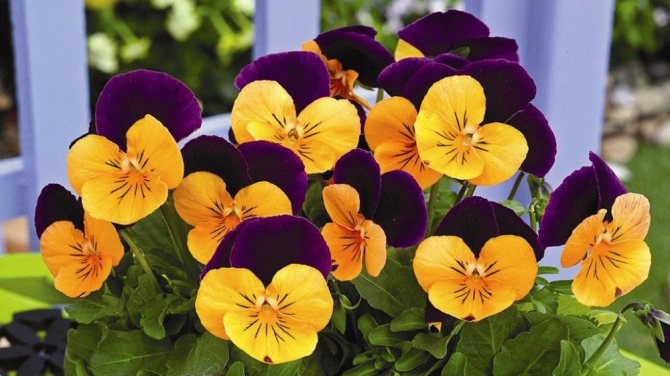

Bicolor pansies
All types of pansies are included in 15 groups of ornamental and garden varieties, differing in terms of flowering, size and color of flowers, flower shape and frost resistance. Flowers of various groups can be simple, double and semi-double.
A separate group can be divided into the types of the "Russian size" variety series, with a flower diameter of about 10 centimeters, and the "Waterfall" variety series - a novelty of ampelous type for hanging pots.
The most popular varieties with photos
There are two categories of pansy varieties:
Often, beginner growers buy large-flowered Pansies., thereby making a mistake, because small-flowered are more hardy and stronger. They are not afraid of rains and sudden temperature changes.
There are three types of plants:
- tricolor violet;
- violet yellow;
- Violet Altai.
Breeders have created many varieties based on the species listed above.
Evening heat
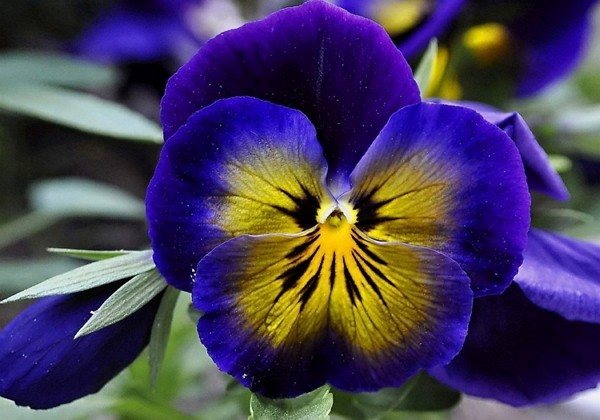

This variety has large, beautiful flowers. They reach 5-6 centimeters in diameter. They grow on a long peduncle that reaches 10 centimeters. The flowers themselves are not very bright, with wavy edges. The bush grows up to 15 centimeters in height.
Ice king
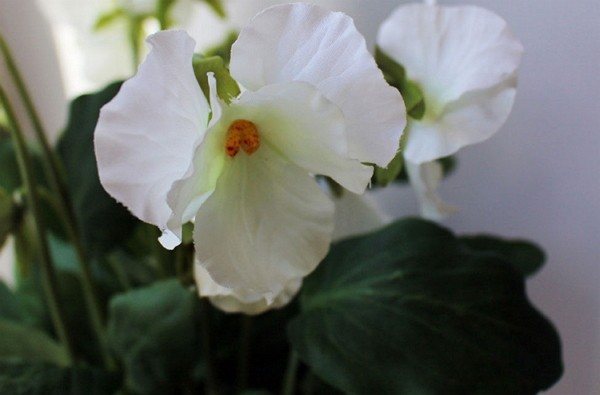

Grows in height up to 20 centimeters. During the flowering period, white flowers with a green tint bloom. The lower petals have characteristic purple spots.
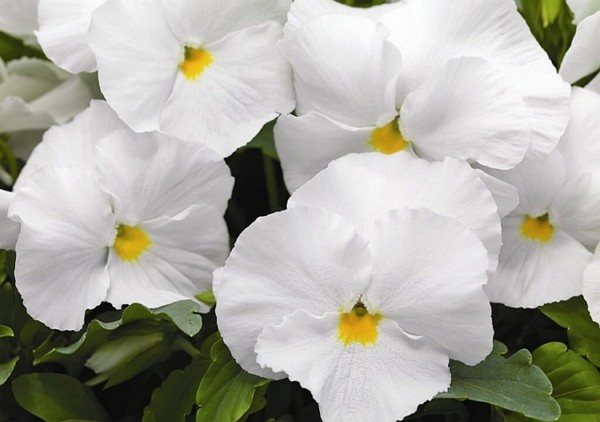

This variety has a gigantic size compared to others. It reaches a height of 25 centimeters. Flowers with a diameter of 6-7 centimeters with a wavy edge. Color - white with a yellow center.
Tiger's Eye
The flower has an unusual color that looks like a tiger. The bush is quite compact, it grows up to 20 centimeters in height. Grows into a lush carpet. The flowers are yellow with black stripes. The diameter does not exceed 3-4 centimeters. This variety thrives in almost any soil, with good drainage..
Adonis
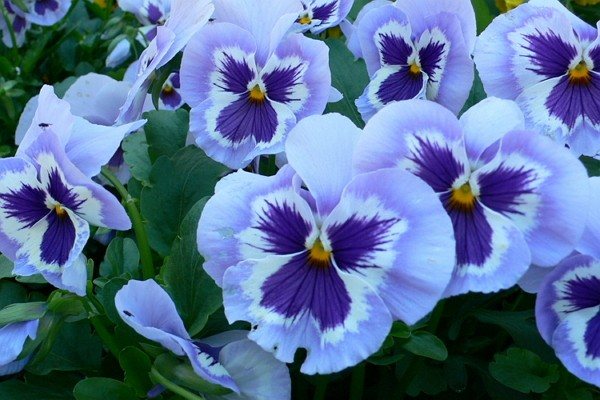

A plant that is distinguished by its fast growth and long flowering. Adonis is quite small, only about 15 centimeters high. Its flowers are large. The top two petals are light blue, and the bottom three have white-purple spots. In flower beds, they are used in groups. The variety is winter hardy.
Reproduction methods
The simplest and most effective method of propagation is considered to be vegetative for hybrid varieties. They are separated by green cuttings in the open field, which allows you to get a large amount of planting material in 1 season. Cuttings are taken in 2-3 doses from May to July. All green shoots with 2-3 nodes are considered suitable. Shaded and damp places are chosen for breeding. They make low rows. After that, they are well tamped and watered.
The cuttings are planted to a depth of 0.5 cm so that the leaves of each cuttings touch. After planting, they are sprinkled abundantly with water. To prevent them from disappearing, cuttings need a good level of moisture, daily watering, weeding and spraying. Such conditions will facilitate rapid establishment.
Some gardeners propagate these flowers by seed. They are taken after flowering bushes. Seed pods form almost immediately after color. They begin to turn brown, after which they open up and scatter their seeds around.
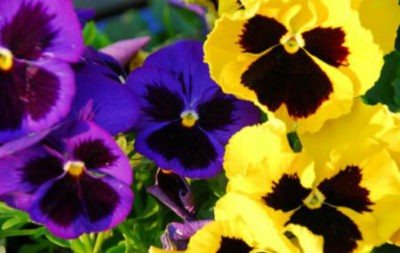

Pansies are a beautiful plant of various colors. It is impossible to pass by them, just like that, without admiring them. These flowers are very popular among gardeners.
All varieties are very similar to each other, they differ only in their color. Today we will talk about the most beautiful of them. You can also watch a useful video on this topic.
The healing properties of the violet tricolor
Violet tricolor has medicinal properties, as its composition is extraordinary... It contains salicylic acid, ascorbic acid, essential oils, tannins and more. Such a wealth of substances is effective in treating diseases.
Actions on the human body:
- Diuretic.
- Expectorant.
- Anti-inflammatory.
- Diaphoretic.
- Heals wounds.
- Relieves itching and irritation.
- Purifies the blood.
- Calming.
Drops made from the plant can even cure sinusitis. Violet tricolor copes well with itching after mosquito bites in young children.
We recommend watching a video about the medicinal properties of Pansies (tricolor violets):
Description
Viola flowers are perennial or annual, in appearance they resemble a violet. Pansies can be called tricolor violets or viola. Translated from Latin, viola means "blue". Popular names:
- Anyutka;
- Brother and sister;
- Moths;
- Troy flower;
- Half color.
Pansies symbolize wisdom, loyalty and devotion. They are a symbol of spring, as they bloom very early.
Pansies are popularly called the flower of the Holy Trinity. The dark core represents the all-seeing eye, the diverging rays - the radiance. The peaks symbolize the three faces of the Holy Trinity. In the old days, the pattern of flowers was crocheted by girls.
The plant was brought from Central China and Japan. Due to its bright and unusual appearance, it quickly gained popularity among gardeners. The name of the flower has changed over time. In Russia, the flower has long been called "Trinity color". The official name "Pansies" was assigned to the tricolor violet in the Encyclopedic Dictionary, which was compiled by Russian scientists in the period from 1861 to 1863.
The flower is grown in the southern regions, but breeders have obtained varieties that make it possible to grow the plant in central Russia, the Moscow region and the Urals.
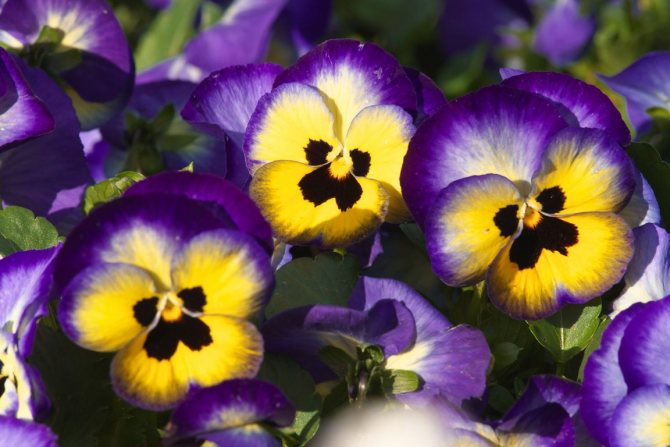

Pansies
The flowering period begins in early April and ends in late summer. Description:
- The plant is an annual or perennial;
- The diameter of the flowers is from 5 to 10 mm;
- They have a light delicate aroma;
- Flowers can look different, there are several shades: purple, blue, white, yellow. Petals can differ in color: monotonous, double, petals with bright spots and stripes;
- Pansies differ in the size of flowers, depending on the cultivar. There are small, large or giant flowers.
According to the height of the bush, the viola is divided into:
- Stunted;
- Average;
- High.
Viola can be called a versatile garden decoration plant. There are more than 15 main varieties of viola. Bushes grow up to 15-20 cm in height. The plant grows quickly by self-seeding, forming beautiful flower beds with lush, bright flowers. The roots are 20 cm deep in the ground, the leaves are delicate green. Flowers are propagated by seeds and by cuttings. The plant is grown for decorative purposes to decorate cottage villages, garden plots, gazebos.
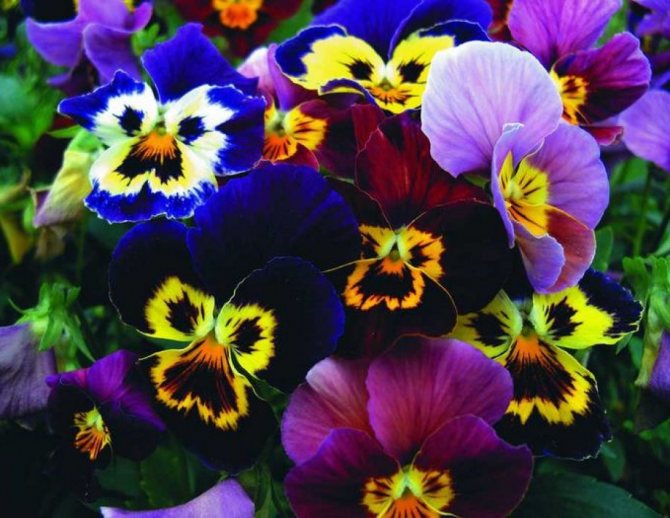

The flowering period begins in early April
Flower legend
There are many legends about the flower and its origin.... One of the legends says that once the girl Anyuta showed excessive curiosity. She became interested in the details of the lives of strangers. And as a punishment they turned her into a plant.
Ancient Russia had its own beliefs about Pansies. They said that because of love, the girl Anyuta turned into a flower. She fell in love with a young man who reciprocated. But since the young man was from a wealthy family, his parents insisted that he marry another, better off. Anyuta could not stand such a betrayal and died.
There was also another legend. A girl named Anyuta lived in the village. She was gullible and kind. Once, a young man of attractive appearance came to her village. Anyuta could not resist and trusted him, and he deceived her. The guy said he would come back for her, but he never came again. The girl soon died of melancholy, and wonderful flowers bloomed on her grave that looked like her beautiful eyes.
In Germany, Pansies are called stepmother... And this name was not invented by chance. The lower petal is the largest and most beautiful. The petal symbolizes the dressed up stepmother. The petals a little higher are the dressed-up daughters. The two remaining petals symbolize stepdaughters in poor robes.
A bit of history
The romantic name Violet tricolor is due to its appearance. Its petals really resemble large eyes.
There is a legend that the girl Anyuta was waiting for her lover and, without waiting for him, she died of melancholy. On her grave, unusual flowers have grown, reminiscent of eyes constantly looking into the distance.
Different peoples have different versions of this legend, but they all speak of love and fidelity.
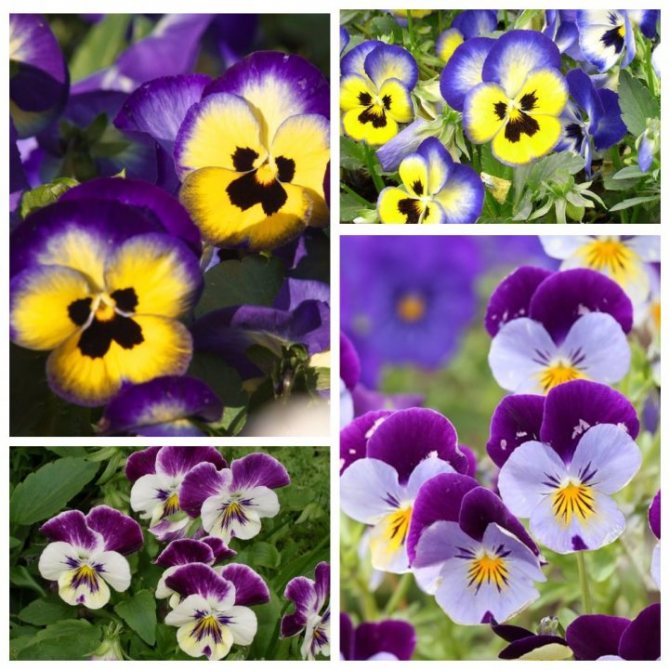

Pansies or viola: planting and care in the open field. Popular varieties
Pansies - a herbaceous perennial plant, grown as an annual and biennial, is also called viola or tricolor violet. It belongs to the Violet family and includes more than 500 species.
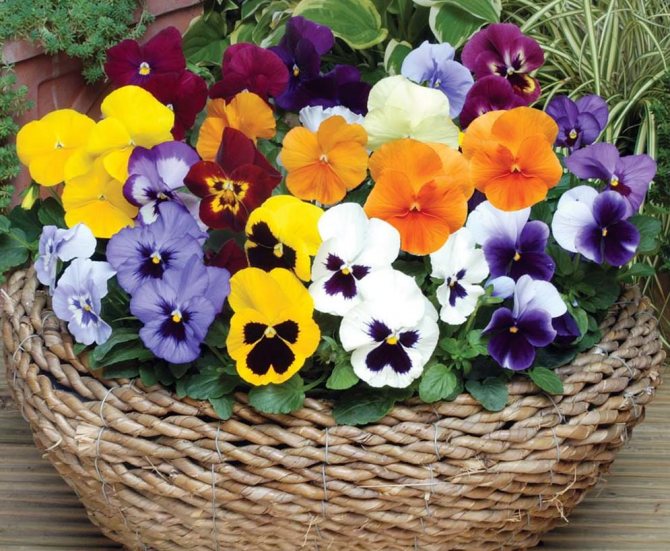

It comes from Europe, but spread widely throughout Russia. The fame of viola is largely due to its unpretentiousness, resistance to bad weather, long and early flowering, and an unusual shape of flowers. The petals are distinguished by their brightness and varied range of shades - from black, purple and blue to white and yellow, including variegated, mixed colors and an interesting yellow "eye" in the middle.
Pansies in landscape design
Brothers or tricolor violets are in great demand among landscape designers: they adorn garden plots, streets with spectacular flowers. Such flower beds look elegant and decorative. Flower crops are selected by size, color scheme. A good combination gives the use of some viols, but different shades. The benefits of using violets are as follows:
- large selection of color palette;
- earlier flowering;
- simultaneous flowering of young crops.
The use of moths in the garden is varied. They are used as the main, complementary or bordering plant. On the basis of three-eyes, designers lay out real floral ornamental carpets, plant paths or decorate pots with them. Moths match perfectly with colors such as:
- Viola horned;
- Iberis;
- Daisies;
- Forget-me-not;
- Asters;
- Lobelia.
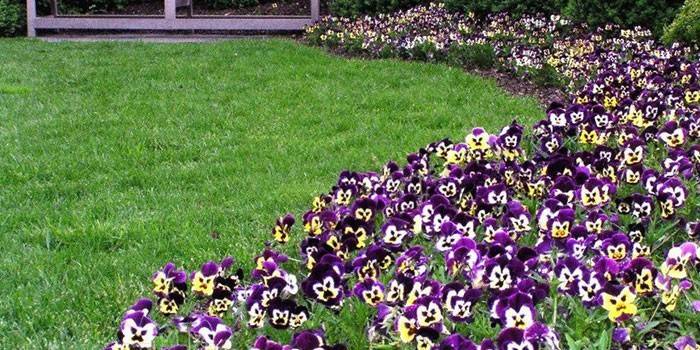

Varieties
The name "pansies" is carried by 2 varieties of violets - the already mentioned tricolor violet and a hybrid created on its basis - the Vittrock violet. They differ in appearance:
- Violet tricolor field Violet tricolor - has a thin, brownish and not too branching root. It grows to a height of 30-45 cm. In the wild, the petals are mostly blue or purple. Small brown and yellow seeds. The plant is used in medicines.
- Violet Wittrock unites many hybrid varieties under its name. The first hybrids appeared in the 18th century. The name of the variety was given in honor of Veit Wittrock, who studied these plants. Viola height - 15-40 cm, flower diameter up to 10 cm. Fibrous root system. Violet Wittrock is a thermophilic, and therefore an annual plant.
Nowadays, breeders have bred a considerable number of varieties of pansies, for every taste and color. Varieties are classified by flower size:
- Small ones. The diameter of the flower is on average up to 4 cm. The most popular small-flowered varieties are Blue Boy, White, and Little Red Riding Hood.
- Large. Flowers from 4 to 6 cm. The following varieties are especially loved by gardeners: "Ice King", "Adonis", "Jupiter", "Evening Heat".
- Gigantic. More than 6 cm in diameter, bloom early. These include the "Swiss Giants" variety series.
Varieties are divided according to their appearance:
- Monochromatic - monochromatic, sometimes with small spots or stripes on the lower petals;
- Bicolor - when the upper and lower petals are painted in different colors;
- Spotted - characterized by contrasting spots.
Pansies come with even and uneven edges of the petals; bushes of different heights: low, medium and high; differ in flowering time.
Diseases and pests
Viola tricolor is susceptible to disease and damage from insect pests.
These include:
- Powdery mildew - white bloom on the leaves. The bushes are treated with a fungicide.
- Brown and yellow spotting is a bacterial infection. Treatment with copper oxychloride is required.
- Slugs, scoops and mites - appear as small dots-holes on the leaves. Pests are picked by hand or flowers are treated with special means.
- Aphids - manifested by premature drying of flowers and leaves. A sticky bloom is visible on the plant. Severely damaged bushes must be removed from the site. On the rest, the infected parts should be cut off and the plants should be treated with soapy water or aphid preparations.
- Rot - starts from the root and spreads to other parts. The color of the leaves changes, and the roots become dark brown. In this case, the treatment of the bushes with a fungicide helps. The disease can appear due to high humidity or high acidity of the soil.
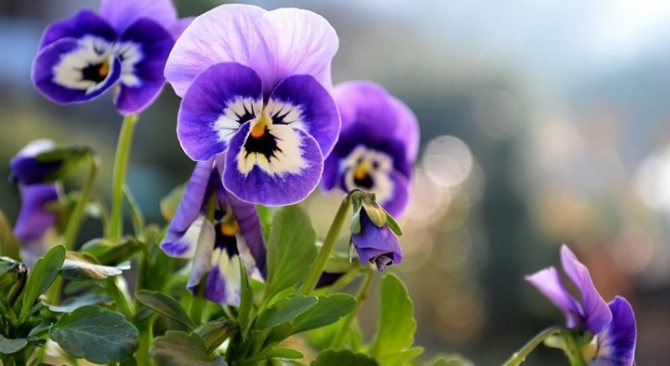

There are many types of these flowers. They differ in the size of the buds, the color and shape of the petals. There are varieties with large flowers - Russian beauty, Empire, Dynamite.
The size of the flowers of these species reaches 8-10 cm in diameter. Other species - Freedom, Aurora, Viola ampelous Waterfall, Viola Williams Vilyur and others have flowers 3-7 cm in diameter.
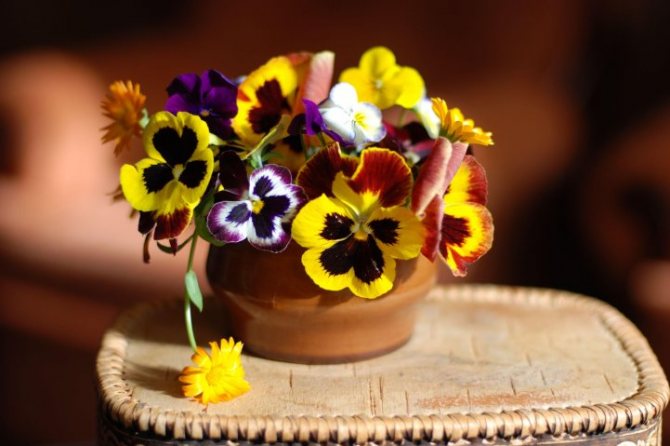

When planting several varieties on one site, it is necessary to maintain a sufficient distance between different ones. Flowers are capable of being highly pollinated. If this is not done, then next year you may not see some species on the site.
Pansies are beautiful and unpretentious flowers. With proper care, they will delight you with their beauty all summer long. Following simple planting and grooming guidelines will help you achieve good results.
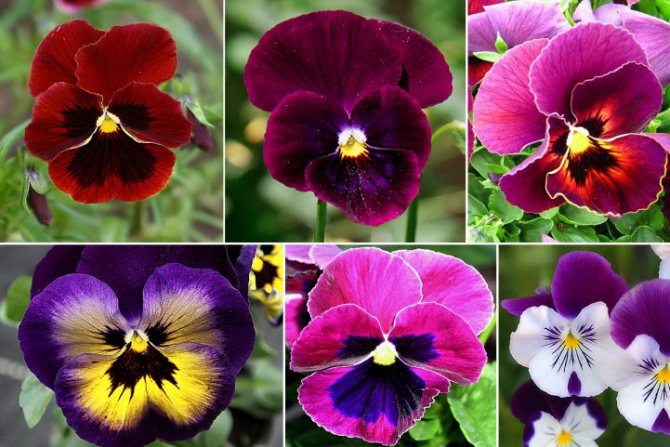

Choosing a landing site
Viola are light and heat-loving plants, it is advisable to plant them so as to provide them with an influx of sunlight for at least 6-8 hours a day. An interesting fact - the flowers of pansies in the sun grow especially large and colorful, but they do not bloom for a very long time. But in shaded places they grow, albeit smaller and not so bright, but their flowering lasts much longer. In general, the planting site depends on the characteristics of the variety.
Viola prefers loose, nutritious, moist, well-drained soil with a neutral acidity level. Feels good on sandy or loamy soils.
Features of planting and care
Before you start growing violets, you need to study it varietal features and growing technique. Viola is a winter-hardy and shade-tolerant plant. However, you should pay attention to the choice of a place for a flower bed.Lack of sunlight will affect the flowering time. Hot, open sunlight will speed up the flowering period and make it short. The flower stalk with a bud will stretch out, and the size of the flower will become small. The best place to grow violets will be a place open to sunlight in the morning and evening and with shade in the daytime sun.
Violet needs protection from drafts. Planting a plant on an alpine slide will help you get an excellent result. The optimum temperature for growing flowers is 15 ° C.
For correct development, growth and reproduction of viola, it needs fertile soil. The flower grows well on loamy and sandy loam soil. In this case, the plant needs to provide good drainage. The absence of excess moisture will preserve the root system of the flower, which is located superficially in the violet, from damage by rot and disease. When arranging flower beds, the soil is dug up, sand and peat are added. The composition is thoroughly mixed.
Landing rules
Pansies are planted at different times of the year, depending on the climatic conditions of individual regions and on the desired flowering and growing period. Due to these features, there are two landing methods:
- Sowing with seeds... Violas are grown as biennial plants. In this case, the seeds are planted in a previously prepared, open ground. In the northern regions, this usually occurs at the end of July. Seedlings appear in two weeks or a little earlier. There are several important points associated with this method:
- The soil for the nursery is made from a mixture of peat, humus, garden soil and sand in approximately equal proportions. At the end of summer, they are transplanted to a permanent place, so that the distance between them is between 10-30 cm.
- Planting time is vital. It is believed that pansies resist frost well, but severe winters are fatal for them. This is especially true for those plants that were planted too late. Weak seedlings will not tolerate cold snaps and are likely to either freeze or weaken. On the other hand, if the viola is planted too early, they can have time to bloom and, accordingly, also weaken, outgrow and, quite possibly, tragically die from overheating.
- The wrong landing site is also dangerous. Abundant dampness and too wet soil are not good for flowers.
- Planting seedlings. This method is used when you want to achieve early flowering. In this case, the seeds are planted in containers or greenhouses in late winter or early spring. The seeds are covered with a thin layer (about 4 to 5 mm) of treated soil, then covered with foil or glass. Seedlings appear on average after 10 days. The successful cultivation of viola in this way requires compliance with three factors: Soil preparation - sufficient moisture is required, but not waterlogging;
- Maintaining the temperature, the most optimal is considered to be + 20 ° C. Decreasing or increasing the amount of heat can lead to stunted growth. After the sprouts appear, the temperature is gradually reduced and the film is removed;
- Good lighting, if necessary, simple lamps or phytolamps are used.
Seedlings are fed with fertilizers with phosphorus, nitrogen or potassium to increase growth rates. Usually feeding is done after 20-22 days.
For the first time, the plants dive after the appearance of the first two leaves. At the same time, you can not feel much excitement - although transplanting is a difficult and cautious business, the flowers survive even slight damage to the root perfectly. Even transplanting viols during flowering does not bring them any inconvenience - they are often planted at this moment. Moving a plant to a new place of residence, it is carefully shifted into a hole along with a lump of earth and watered.
- Violas need timely, but not too frequent watering. The main thing is to observe the measure: when waterlogged, the flowers can rot. It is important to maintain soil moisture.
- On dry soil, flowers grow poorly, become smaller in size, this is especially true for large-flowered varieties. The problem is solved by introducing humus and compost into the soil. You should not fertilize flowers with manure, they do not like it. Top dressing is done infrequently - once during budding and during flowering.
- Basically, caring for viols is reduced to weeding and loosening the soil to saturate with oxygen.
- During the flowering period, faded buds are removed in time.
- For the winter, biennial plants are covered with straw or woody foliage, and left to winter. The danger is represented by severe winters with a small amount of snowfall and an early thaw with night frosts. In the latter case, a channel is dug next to the garden bed to drain water.
Transplanting
For seedlings, seeds are sown in March in containers or pots. The whole process includes several stages:
- The container is filled with 1/3 of the nutritious soil mixture. Depressions or grooves are made with a depth of 0.5-1 cm.
- Seeds are sown in them and covered with a small layer of earth. Until emergence, containers are stored in a dark, warm place, covered with glass or foil.
- Seedlings appear 10-14 days after sowing. The soil must be periodically moistened with irrigation.
- Containers or pots should be ventilated periodically to prevent decay.
- After the appearance of 2 real leaves, the plants need to be dived one by one into separate containers.
- As they grow, the seedlings are hardened by taking them outside. The residence time in the air should be gradually increased.
- It is possible to plant seedlings in open ground after blowing the threat of night frosts. It is better to do this at night or in cloudy weather. When planting, weak and undeveloped seedlings are discarded.
- Saplings are placed at a distance of 25 cm from each other.
- The planted seedlings at first need to be watered abundantly if there is no precipitation.
- One month after planting, Viola begins to bloom.
You can buy ready-made Pansy seedlings at specialty stores. In this case, you need to choose strong seedlings with a healthy appearance.
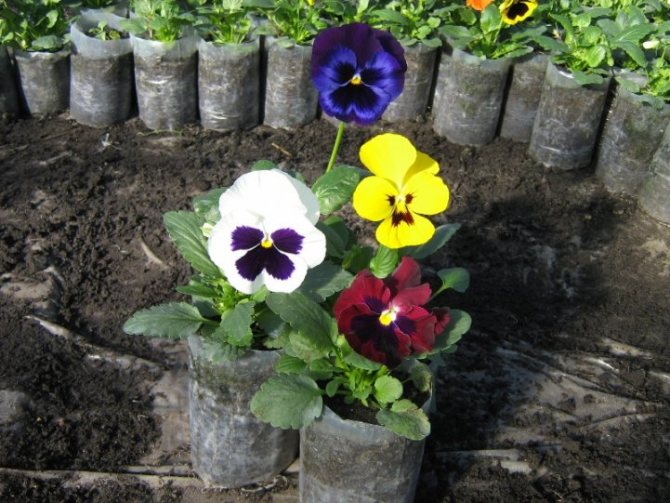

Reproduction
They use 3 breeding methods:
- Seeds... Since viols are cross-pollinated plants, the healthiest bushes selected are planted separately. The seeds are harvested as soon as the boxes turn yellow. Later, the boxes fall off. The collected "crop" is dried up and stored.
- Dividing the bush... With this method, the bush is divided into several inflorescences and they are seated in separate holes.
- Reproduction cuttings... Shoots are cut from May to July, planted at a short distance from each other, rather densely, to a shallow depth in the ground and watered from time to time. After 3-4 weeks, the cuttings take root. When propagated by cuttings in early summer, the bushes will bloom by autumn.
Viola cultivation methods
There are several ways to grow a Vittrock Viola:
The choice of a method for propagating flowers depends on the goals of the grower and the final result that he will receive. Flowers grown in annual culture bloom in the middle of summer in the year of planting, but this method is carried out using seedlings. The desire of the grower to admire the flowering from May to October is feasible if the seeds are sown in the summer. In this case, the violet will bloom next year. An existing violet bush can be propagated even by flowering ones. At the same time, the plant will calmly survive the division and will not suffer, continuing grow and bloom.
Seed breeding method
To cultivate a plant, you can purchase seeds from a specialty store or use flower seeds that have grown on the site before. Pay attention to the expiration dates of the seeds. If seedlings do not appear within 10 days, then you shouldn't wait for them... Germination time depends on the variety. When purchasing seeds, pay attention to this. The manufacturer must indicate the germination time for a particular variety.
Before planting seeds, if desired, they should be pre-prepare... The seeds are soaked in a stimulant solution for 24 hours. You can apply root, zircon or epin. The decision on which drug to prefer is taken by the florist on his own. Seed germination is low, so a large number of seeds should be planted. Approximately 50-60 pieces per garden bed half a meter.
You can plant seeds from May to early June. In this case, the plant will bloom at the end of August or September under good weather conditions. In winter, viola leaves with flowers. The next year, flowering begins in May.
The practice of planting seeds before winter is widespread, in August - early September. During this time, the plant sprouts, develops the root system well and leaves healthy during the dormant period. The violet will bloom next year.
Seeds are sown in prepared soil, while the seeding depth does not exceed 5 mm. A thicker layer of soil will prevent the seeds from germinating. The soil needs to be loose, light.
At first, the plant needs the sun's rays, so you should not shade the seedlings. Watering is needed moderate. Try to keep the soil moist and prevent the soil from drying out.
Growing seedlings
The seedling method of growing is the most common among florists. You can get flowers that can grow outdoors by sowing seeds in February or March. Before planting seeds in seedling containers, it is recommended to stratify them by creating an artificial winter. In January, the seeds are placed in a cool place and kept until the period of their sowing in the ground.
A fertile loose substrate will help to grow seedlings of violets. You can buy soil for violets in the store, you can prepare it yourself by mixing garden soil with sand, peat and humus. Containers, seedling cassettes, peat cups are filled with soil, the choice depends on the individual preferences of the grower.
A shallow groove of 0.5 cm is made in a container, seeds are laid out on the surface (a distance of 1-2 cm from each other). The groove is lightly covered with earth. Water the containers with warm, settled water or spray them with a spray bottle. The drawers are covered with foil and provide warmth. Lighting, while there are no shoots, does not matter. The containers are periodically ventilated. The emerging seedlings gradually accustom to the surrounding climate on the window. To do this, the opening time of the film is gradually increased, and over time it is removed completely.
Seedling care consists in timely watering. Do not allow the top layer of soil in the container to dry out. The amount of water should be such that the surface of the earth is moist and not wet. Do not fill the boxes, pour excess water out of the tray.
Plant picking is required as soon as two true leaves have grown. Small violets are seated in separate containers. The plant is deepened to the cotyledonous leaves.
Pinching the crown of the flower will provide good bushiness of the viola. It must be done when the flower grows six true leaves.
Seedlings are transplanted into open ground when stable warm temperatures are established. On the glazed balcony, the viola can be planted in containers and pots at the end of March. The volume of soil in the pots should be at the rate of 2 liters per one bush. Flowers are usually planted in a flowerbed with open ground in May or June. The distance between the bushes is 10-15 cm.
Reproduction by dividing the bush
It is recommended to divide the existing violet bush in spring or autumn. However, the reason for the division will be the formation of small flowers on the plant and their small number. The violet will survive division in the summer. The divided plant will continue its abundant flowering, and the flowers will recover in size.
As the plant grows, it forms shoots that take root in the ground. They should be separated from the mother bush and transplanted into a separate hole. Sometimes this method is the only one in viola reproduction. Some varieties and hybrids are not capable of producing seeds with maternal qualities.
Shoots with two or three buds are suitable for reproduction. It is not worth deepening them. The hole is made 1 cm deep. New bushes are watered. Rooting occurs in about a month, the young bush gives new leaves.
During the rooting period, the violet must be shaded and not allowed to dry out the top layer of the soil.
Harvesting and drying
Garden-grown pansies are harvested like herbs. Harvesting is carried out in summer. Collect the grass without the lower part of the stem and dry in a place not exposed to the sun, but warm, ventilated. The herb can be dried in a dryer at 45 degrees, the drying time is 2-8 days, depending on the method. The herb does not emit any aroma, it has a sweet taste. Plants should be harvested during full bloom.


Combination with other cultures
Pansies are actively used by designers to create a unique and vibrant landscape. The plant goes well with many perennial or biennial crops such as asters, daisies, lobelias, forget-me-nots and others.
When choosing matching colors, you should choose crops that are suitable for each other in growth.
To get an interesting composition, growers often use monochromatic viola varieties. Also, carpet paths are created from flowers, planted next to curbs, placed in hanging pots.
Decorative items with pansies
Viola and the language of flowers
Flowers were brought to Russia at the beginning of the 18th century. Mini-bouquets served as an addition to the outfits of high society ladies. A garland of pansies adorned the hairstyle and belt of Anna Karenina's black ball gown. In the language of flowers, this meant the beginning of falling in love and thinking about one person. Flowers similar to butterflies quickly settled on ladies' hats and umbrellas.
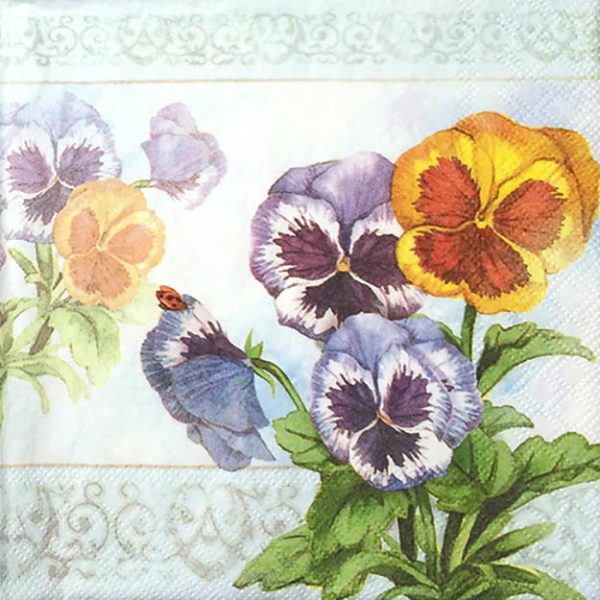

Pansies on napkins
Lilac-yellow pansies look at us from napkins, tablecloths and curtains, embroidered in the 50-60s of the last century.
Gardeners appreciated this fragile-looking, but unpretentious plant. Pansies have become popular in the design of city parks and home gardens. Their combination with early bulbous flowers is successful: viola replaces hyacinths and daffodils that have finished flowering.
Gallery: pansy flower (25 photos)
Viola application
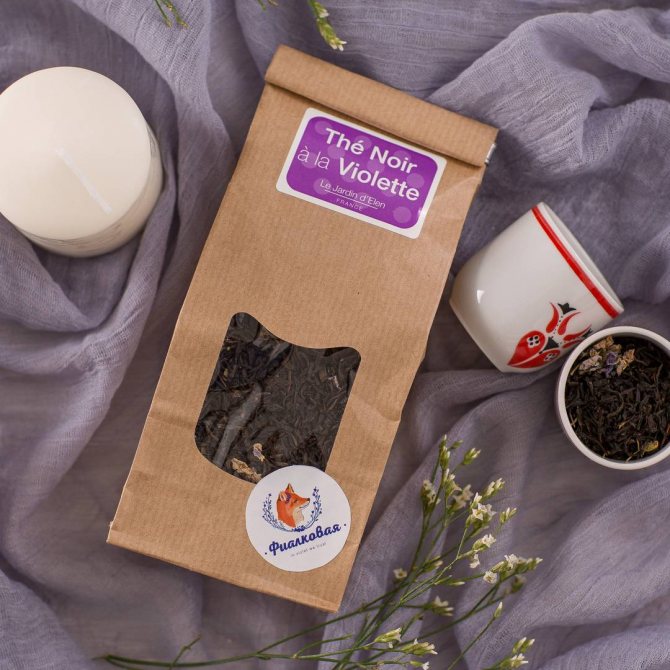

Violet tea
Pansies are a medicinal and edible plant. In medicine, the plant is used as a diuretic and expectorant. It is widely used in homeopathy, used to treat skin and gynecological diseases. In cooking, desserts are prepared from viola: they add petals to jelly, yoghurts, and are used to decorate cakes. The petals are candied, served with homemade cocktails, or brewed with tea.
Pansies are a beautiful and useful flower. It does not require special conditions for growth, it grows well by self-sowing and pleases the eye all summer.
What is the right way to do it at home?
Growing viola at home or in greenhouses will be more fruitful, since the sprouts will be provided with enough attention and care. Usually, pansies are grown at home by people who have acquired an expensive type of plant and want to get the most beautiful flower bed with many bright colors.
Pot selection, soil composition, fertilizers
The soil can be bought in specialized stores, and add a little sand to it., this is what will allow the roots to develop better. You can also prepare your own soil by mixing peat with garden soil, humus and sand. Pansy seeds should be planted in this mixture and sprinkled with a little water.
For the best effect, it is better to place the seed boxes in a dark place, so the growth process will be accelerated. After the first leaves sprout, the pots can be taken out into a bright room.
After planting the seeds, you should wait for the first leaves to grow... Then you need to transplant the seedlings into separate pots. Viola usually tolerates transplanting well.Experts advise to allocate a separate pot for each sprout, and put them on the windowsill.
The soil for the seedlings will be the same as for the seeds, but it is necessary to add mineral fertilizer. These actions will restore roots that are damaged during transplantation.
When to plant?
In order to answer the question of when to plant pansies, you need to know what exactly this plant is for. If the seedlings are needed for sale, then the seeds are planted in December-January. By the beginning of spring, the seedlings can already be sold. If the viola is needed to decorate your own flower bed, then the ideal time for planting pansies is early spring. At this time, the most favorable climate for plant germination.
There is no special preparation of seeds for planting.... It is because of this that many gardeners give preference to pansies. The only condition will be a successful purchase of seeds in proven places, so that further work is not in vain.
What conditions are needed?
The seeds should germinate at a low temperature, between 17-20 degrees. The lighting should be dark, but as soon as the leaves appear, the flowers should be transferred to a bright place. The soil must always be kept moist.
Growing from seeds
The planting time of the seeds will differ from what the grower wants to achieve.... If he is going to get flowers that will decorate the flower bed for two years, then the seeds should be planted in June, but if he is more interested in flowering for one year, then planting is possible in February-March.
Summing up
Thanks to the variety of varieties of pansies, you can make a bright composition in one flower bed by combining different types. But, in order not to lose the decorativeness of the plantings, it is important to provide the plant with proper care - in particular, timely watering, then it will delight others with its unusually beautiful flowering.
Every gardener dreams that his personal or summer cottage plot, even if it is of a modest size, looks attractive. However, not every person's strength, desire and capabilities allow him to be at the dacha around the clock. Especially for those who really want to admire the beauty of flowering plants, while paying them a minimum of attention, in a special article we will tell you which perennial flowers for the garden, unpretentious, long-blooming and incredibly pleasing to the eye to choose.
Video - Sowing and picking viola
Picking
Seedlings begin to dive closer to the second month of spring. This procedure has several stages:
- It is necessary to prepare containers for each sprout. If there are too many seedlings, then another, more spacious box can be used for such purposes.
- The glasses are filled with soil mixture. It is necessary to use garden soil, in which further planting of seedlings is planned.
- The soil should be thoroughly moistened and a small hole should be made in it for planting.
- Then you need to water the soil abundantly in a container with seedlings. After that, each sprout is carefully removed (for such purposes, you can use a wooden stick).
An important point! Seedlings that are in peat pellets do not dive. They grow there until they are planted in open soil.
Sprouts dive into glasses
After a dive, care should be taken for the seedlings:
- moisten the soil;
- during the day to take containers to the balcony
- after the appearance of five or more leaves, you can cut off the top of the plant so that the bush grows on the sides;
- keep the temperature around 15-17 degrees.
Pansies plant care
Thanks to winter hardiness and endurance, it is not difficult to grow modern varieties of viols. An open space and soil with good drainage is probably all they need. If you live in the south, planting them in lace shade will help the plants survive the heat more easily. Regardless of the climate, the soil must have good drainage. If the soil is hard and damp, the pansies will develop root rot.To avoid this misfortune, first plant them in a high bed.
What to feed? With compost, of course. They do not need any other fertilizer. If you don't have compost, use any other organic fertilizer that is relatively high in phosphorus and potassium and low in nitrogen.
If you want to maximize the flowering period, remove wilted ones regularly. Since their roots are rather shallow, mulch them with straw or grass clippings when the heat comes - this will also prolong the flowering period. If they still bloom in August, do not forget to cut the seed boxes, and the flowering will continue throughout the fall.
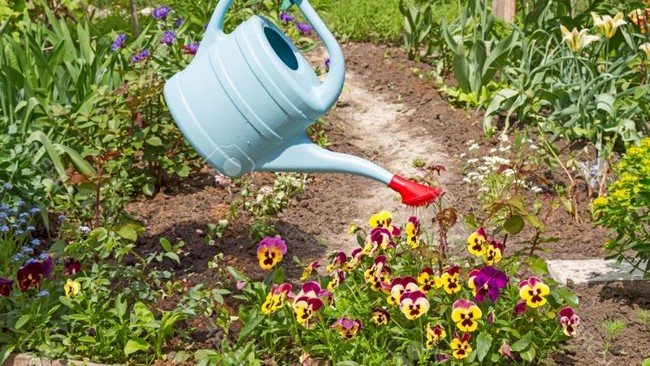

Garden, vegetable garden and flower garden tips
Grapes in the spring processing and feeding from an experienced agronomist
Strawberry diseases description with photos and treatment methods
Cereal diseases and control measures
Popular varieties on the market
Variety of viola seeds, you can choose for every taste
Pansies lend themselves well to selection. The huge number of bred varieties and hybrid forms provides not only richness of colors, but also different time and duration of flowering, flower size, frost and heat resistance. The generally accepted classification can be represented as follows:
Viola small-flowered
"Frosty morning"
The variety blooms so profusely that it has found its use in baskets and hanging pots. Bushes are short, only about 15 cm, but spread up to half a meter. Flowers are white-yellowish with blue-blue, 5-6 cm in size. Prefers brightly lit places. Can be grown in a greenhouse.
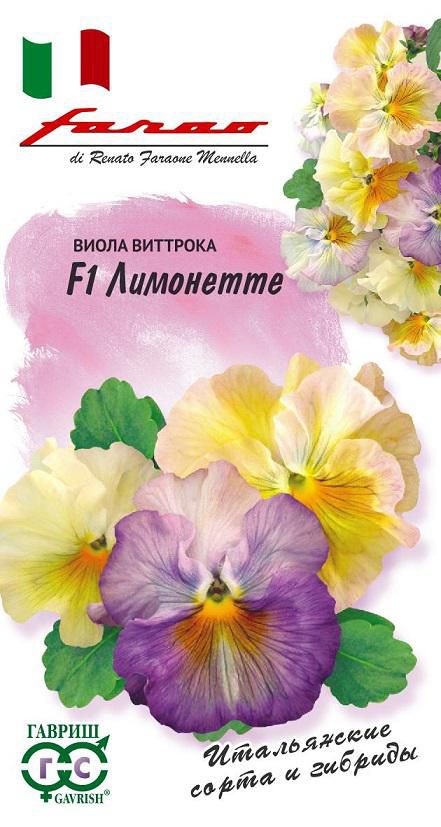

"Limonette F1"
A very beautiful representative of the Flamenco series. The flowers are strongly corrugated lemon and pale lilac shades - in combination with terry planting, they look surprisingly light, airy. Bushes about 15 cm, suitable for growing in containers and outdoors in light and partial shade.
"Summer Wave", series
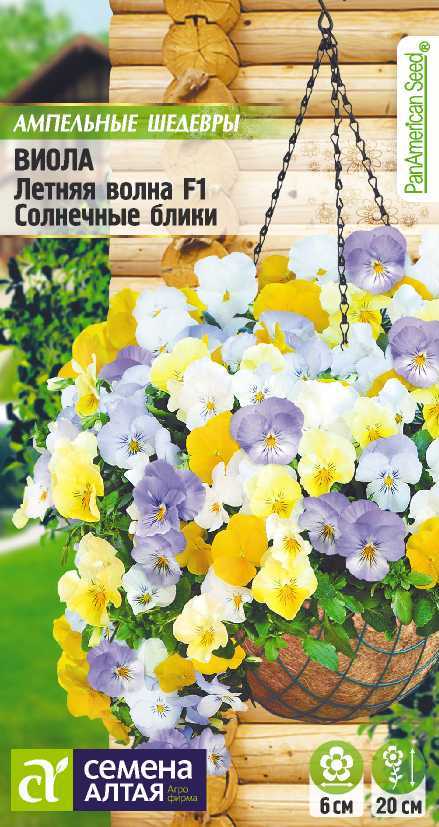

Magnificent ampelous viola. With a bush height of 20 cm, flexible lashes grow up to 60 cm. Flowers 5-6 cm in diameter, from delicate pastel shades to bright purple. The series is frost-resistant; after wintering in the open field, it blooms in April-May and lasts until late autumn. Requires partial shade.
Viola grandiflorum
"Kan-Kan" series
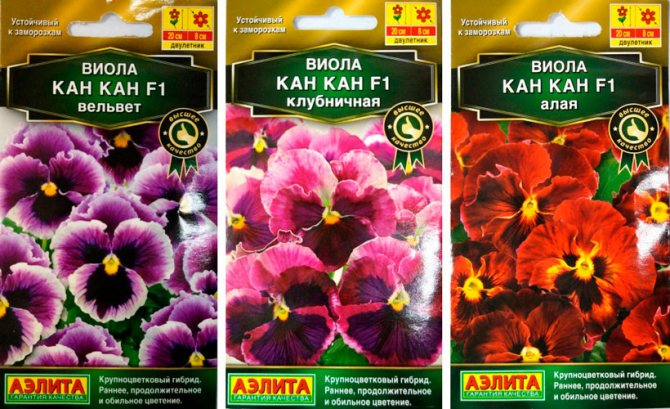

A series of heterotic hybrids with excellent decorative qualities. It blooms with bright, slightly corrugated flowers, 8 cm in size. The flower petals are dense, slightly velvety, resistant to unfavorable weather. The culture blooms early, at the seedling stage. The decorativeness of the plantings remains until late autumn.
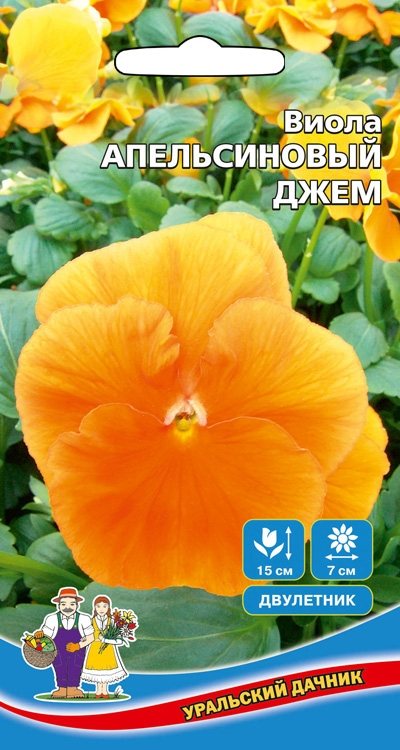

«Orange jam "
Part of the Swiss Giants series, it is distinguished by rich bright orange colors. The size of the flowers is 7 cm, the height of the bush is up to 15 cm. The plant blooms profusely, retains its appearance until late autumn. It adapts perfectly to the summer heat. Suitable for containers and open ground.
"Freezle Sisle Raspberry"
It can grow as a biennial. Suitable for growing in flower beds, mixborders, rockeries, alpine slides. Grows well in a greenhouse. Terry flowers, 7-8 cm in size. At low temperatures, doubleness increases. In the open field requires partial shade or diffused lighting.
Viola gigantic
«Matrix F1 ", series
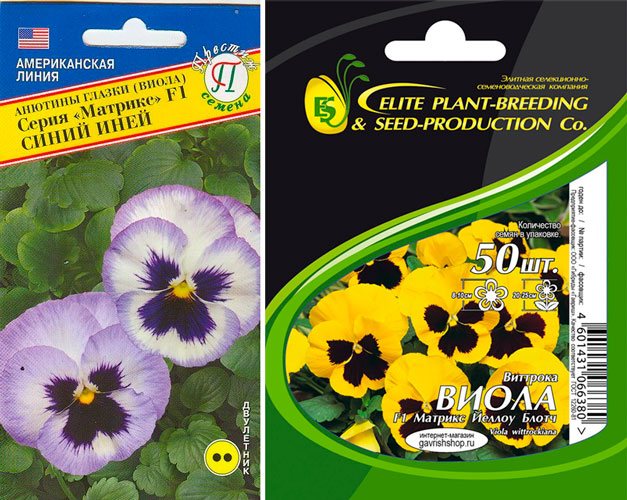

Bred by American breeders as a series of professional gardening. The flowers reach 9 cm, the bush is 20 cm high. It blooms for a very long time, uniformly, regardless of the length of the day and temperature. Grown in greenhouses, containers, open ground. Not suitable for winter sowing.
"Sello" series
A short, compact bush, only 15 cm, but with very large (10 cm) flowers of different colors. The series is resistant to bad weather, blooms very early. Suitable for industrial cultivation in a greenhouse.
How to choose the right variety
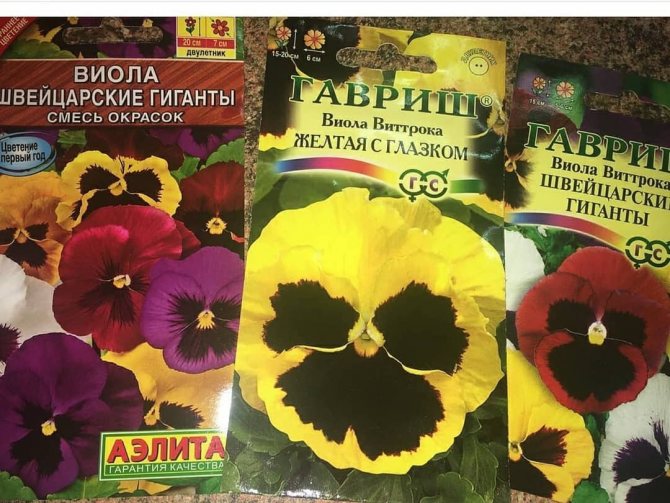

The choice of the desired variety is approached, first of all, for reasons of its purpose: will the flower decorate a flower bed, borders, balconies, or will it be grown for cutting and sale.In hanging pots, ampelous series look best, in pots and vases - low spreading or compact bushes of abundant flowering.
Expert opinion
Mikheeva Tamara Gennadievna
Dedicates most of his time to flower beds in his garden and landscaping
Ask a Question
Unfortunately, the color declared by the manufacturer does not always correspond to the real one. For example, the packaging will indicate a sky blue shade, but in fact it will grow dark blue. In this case, you can ask for advice on the dacha forums or act by trial and error. Typically, such misses concern monochromatic varieties.
When growing violets, take into account the fact that in brightly lit flower beds, flowers are very small, even in large varieties. This is very good in its own way, since it is the plants of small sizes that are most resistant to all kinds of whims of nature. Small-flowered varieties dominate even in the southern regions, where not only warmth, but also winds, showers, hail reign.
In partial shade, on the contrary, larger flowers are formed. Their size usually corresponds to the size stated by the manufacturer on the package. However, large-flowered varieties are more sensitive to external conditions, so they are more often grown in protected areas and in greenhouses. In the shade, the color of the petals becomes dull.
Appearance
What does an annual or biennial terrestrial herb look like?
Root
By the pansies thin, rod-shaped, slightly branched root of brown color... It penetrates into the ground almost vertically.
Stem
It is also branched. It is triangular. The stem is either pubescent or glabrous. The hairs are bent down. It is hollow inside. Its height is 10-30, occasionally 45 cm. Sometimes several creeping and erect stems extend from one root.
Leaves
The arrangement of the leaves is next... They are petiolate. They can be either naked or sparsely hairy along the veins. The lower leaves are broadly ovate. The petioles are long.
The top leaves look different. They already have an oblong-lanceolate shape. On them, the petioles are already short. Each leaf has two stipules. Their shape is pinnate-lyre. They are longer than leaf petioles.
Flower
Frontal simple brush - inflorescence type. In due time, zygomorphic flowers appear on the peduncles of the pansies. Peduncles emerge singly from the leaf sinuses. In the upper part of the peduncles, very close to the flower, there are two small bracts.
The calyx of the flower is formed by five leaves... It does not fall off after flowering. The shape of the leaves is elongated-lanceolate, pointed. They are soft hairy. The lower sepals are larger than the upper ones. Corollas are collected from five loose petals.
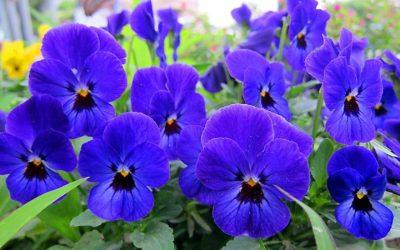

The color is dominated by blue and its various shades. All the petals that form the flower are of different shapes and sizes. There are many legends about flowers and their color, but pansies are what they are - beautiful, unique and memorable.
The number of stamens is five. They are pressed against the pistil. They are in contact with anthers with stamen filaments, which are short and barely noticeable. The flower has one pistil.
Seeds and fruits
After the pansies have faded, the fruit will form... It is a greenish box with a length of up to ten millimeters. The seeds in it are located close to the walls. A cup surrounds the box. When it is fully ripe, three leaves will open and the seeds will fall out.
The seeds are small. Their length is 1.25-1.75 mm, and their width and thickness are 0.75-1 mm. Their shape is obovate. There is a small appendage. They are either light yellow or light brown. When pansies are planted early, they will bloom early and discard their first seeds in June.
One box can contain up to 3 thousand seeds with a total weight of 1.5 g. If you collect the seeds and organize proper storage, they will retain their germination capacity for up to 2 years.
For details on how to grow a violet "Pansies", as well as about the basic rules of planting and caring for a flower, read our material.
From seedlings
Seeds should be planted in boxes and stored in a greenhouse or other warm place. Thus, by the planting season, enough seedlings will sprout to create a gorgeous flower bed.
What should be the soil?
It is imperative that the soil is not loose... The soil can be purchased at any specialty store, and for best results, experts recommend adding sand. Mineral fertilizer is perfect for growing pansies.
Preparation
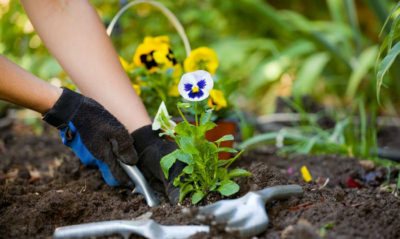

If the gardener decided to be content with the flowering of pansies in the near future, he needs to start growing seedlings. One of the important stages in this activity is picking the leaves.
The picking of the plant must be carried out very carefully, since the leaves of the flower are rather fragileand any wrong movement can ruin the whole plant. It is necessary to remove the seedlings from the box along with a piece of soil, so that the sprouts will remain intact. Since this type of work is rather difficult, you can accidentally damage the roots, this does not mean that the plant will die, it just slows down slightly.
After the plant is planted in the hole, it must be covered with a layer of fertilized soil, and then watered.
How to put into the ground correctly?
Most often, the most optimal weather occurs in May, when there is no longer a chance that snow will fall, or the air temperature will drop too low.
The choice of location should be treated with a special approach. Seedlings should be planted in a bright place.so that the sun's rays hit the flowers.
At the same time, the territory should not be open, as in this case, the flowers will simply burn out. The most ideal place would be an area with several trees.
Particular attention must be paid to the soil. It should be loose and airy. It is under such conditions that pansies will bloom quite quickly and will delight others with their beauty. The distance between the seedlings should be 20 cm.
Follow-up care
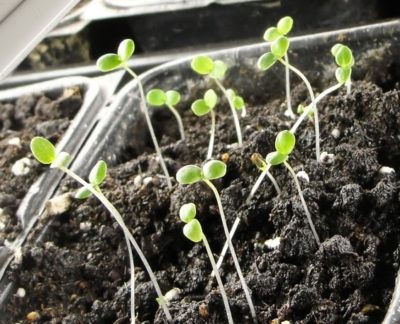

After the seedlings are planted in the ground, the following steps should be taken:
- Regular fertilizing with mineral fertilizers... The most suitable are those that contain nitrogen, phosphorus, potassium. Viola should never be fertilized with fresh manure.
- Loosening... Pansies will only grow well in a well-loosened area. This process will help get rid of unwanted weeds and allow air to enter the soil.
- Watering... Like any other plant, the viola needs to be watered. But do not overdo it, as a flower that is too moisturized can quickly deteriorate.
How to grow pansies with cuttings


The best shoots from the bush, after their formation, dive to a permanent place
Everything is very simple. They take the desired bush at the stage of budding or even flowering, it does not matter. They choose the best shoots from him, where there are 2-3 knots and cut off with a sharp pruner. They are planted immediately in a container (cuttings), where drainage and a mixture of garden soil from sand are prepared. They are planted so that one knot is dug in, moderately moistened. Further, the container with cuttings is removed to a shaded place, and in a month, fully formed bushes will grow. After that, they begin to pick plants to a permanent place.
Description of the plant
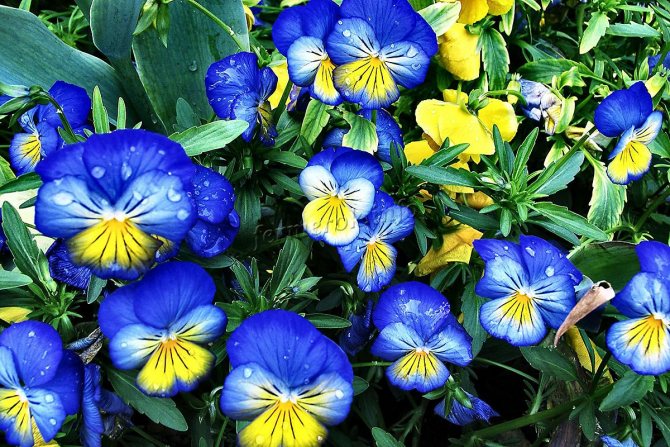

Pansy Flowers
The homeland of the pansy flower is Europe. As new species appeared, the plant was domesticated, it spread throughout the world. The popularity is largely due to the fact that home care is not difficult, but culture is mainly prized for its beauty. This plant grows with a bush 15-30 cm high.
Flowering is usually early and long lasting. The bud is located on the peduncle. Flowers have an unusual shape and color, and this is what attracts attention.A flower can have different types of petals: straight, double, with smooth or wavy edges. The petals are always bright and combine different colors and shades. Viola's palette includes white, yellow, black, purple, blue, red and pink, as well as many other colors. But the middle, as a rule, is yellow and although it is very small, it is difficult to miss it.
How to care for pansy seedlings
Caring for viola seedlings after planting is a necessary stage of plant growth that requires your time and effort. But it will help to grow strong and healthy seedlings. It is necessary to take care of crops before germination using the following technology:
- After sowing, place the bowl in warm dark place... Temperature regime - + 20-21 ° C.
- Water before germination follows from a spray bottle... The soil should always be moderately moist.
- everyday ventilate container, removing the covering material. A must every time wipe off the condensation from its surface.
By the way! With proper sowing and care, the first shoots will appear in about ten days.
After the emergence of seedlings, the care changes slightly:
- Remove permanently the film or cover.
- You need to transfer seedlings to a well-lit place... Plants must receive light for at least 12 hours, so they need supplement (both before the pick and after).
- Should reduce the temperature to 12-15 (but not more) degrees of heat.
- Now water should be from a syringe or syringe. Apply moisture carefully so that it does not get on the plants themselves. The soil should remain moderately moist at all times.
Protecting Pansies from pests and various diseases
In order for the viola to become stronger, stronger and more resistant to diseases and pests, it is worth planting it on a garden plot in open ground a little earlier than it should be. Typically, this plant attracts pests such as aphids, spider mites and mealybugs.
When they appear, you should rinse the bushes with water from a hose several times within two weeks. Large areas affected by these insects should be treated with "green soap". Viola will be saved from caterpillars and slugs by infusion of tobacco. And irregular watering on cold, cloudy days will help prevent gray rot and powdery mildew on the plant.
Let's summarize:
Pansies are a beautiful flowering plant, unpretentious and hardy. You can admire the plants for two seasons. If you grow seedlings at home. Sowing seeds at the end of winter. When sown in open ground, anyutki will delight with flowers for the next year. Following all the recommendations and consulting with experts, you will be justly proud of the design of your site or balcony.
loading ...
Growing problems
Seeds do not germinate
The reasons why the seeds do not germinate can be:
- seedlings of poor quality;
- excessive deepening into the ground;
- too dense soil.
If sowing took place recently, be patient. Sometimes the seeds germinate after 2-3 weeks.
Seedlings are too thin
Weak seedlings speak of:
- excessive planting density;
- lack of lighting;
- lack of nitrogen.
In the first case, the seedlings are carefully thinned out. In the second, a source of artificial lighting should be added. With a lack of nitrogen, fertilizing with an NPK complex is carried out.
Viola shoots are strongly stretched
Seedlings wilted after cleaning the greenhouse
After removing the greenhouse, the microclimate near the sprouts changes. Proper watering should be established and the containers should be taken to a cool place out of direct sunlight.
Another cause of wilting can be root rot in the ground.
Photo
Next, you can see a photo of a tricolor violet or pansy:


Want to know more about growing and caring for other types of violets? Read our experts' articles on varieties:
- Optimara;
- Chanson;
- breeder Tatyana Pugacheva;
- Fairy;
- Winter cherry and Frosty cherry;
- Isadora;
- Blue fog;
- Bronze Horseman;
- series AB.
Care after planting seeds
The crop care process includes the following points:
- Daily airing of containers - this will require removing the lid or film and wiping off the accumulated condensation.
- Periodic soil moisture. Do not overfill the container with water, but it is not recommended to allow the soil to dry out.
- Compliance with the temperature regime - it is better to keep the container at a temperature of 19 to 25 degrees.
- Light control. If the direct rays of the sun fall on the container, then it is necessary to artificially create a shadow.
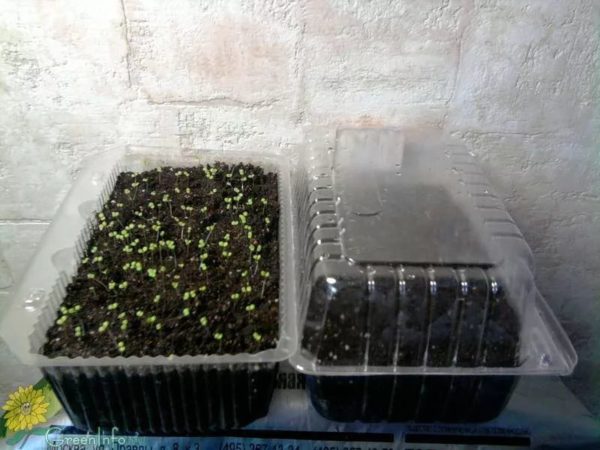

Seedlings must be ventilated
The first shoots begin to appear no earlier than two weeks later, but only if all of the above points are observed.
The process of leaving after the first shoots appear:
- remove the cover from the container (cover or film);
- spray the soil from a sprayer as needed;
- provide the sprouts with about 15 hours of daylight hours a day;
- keep the container at a temperature of about 13-14 degrees so that the seedlings do not stretch out too quickly;
The next step is to dive the seedlings into separate containers, but it is worth considering that for this, at least two leaves must appear on each sprout.
Flowering and possible diseases
When does it bloom? Viola begins to bloom in late spring and pleases those around with its brightness throughout the summer. Despite the fact that the gardener can carefully look after the plant, it is extremely difficult for pansies to avoid various diseases that can destroy the flowers, or make their color dull.
The most common disease in viola is considered to be root or stem rot.... If this disease appears in an adult plant, it is highly likely that it will disappear during the winter.
In summer, weak plants can get sick if the soil is not loosened and too heavy, so it is extremely important to comply with all conditions for keeping flowers.
Diseases such as rust or powdery mildew are less common... But, they are also very dangerous for the life of the plant.
They appear as white bloom on the leaves, and if the gardener noticed this, he needs to treat them with 1% Bordeaux liquid.
It can be concluded that pansies are pretty unpretentious plants, but in order to admire their beauty for a whole season, it is necessary to perform a number of procedures. When creating optimal conditions for growth, viola will thank others with its brightness.
History of origin
It is not known for certain about when and how pansies appeared. There are many legends about the origin of this flower., but which of them are true and which are not, is unknown. Already during the reign of the Gods on Earth, they already existed.
Once the goddess Venus decided to swim away from human eyes. She found a hidden corner in a distant grotto. She splashed in the water for a long time, and suddenly she heard a rustle. Turning around, she saw several eyes of curious mortals.
Venus became angry and punished them for their curiosity. Unable to punish them on her own, she turned to Zeus for help, and he changed his mind at the last moment and turned the curious into pansies.
Pansies are called stepmother in Germany.... This name was not invented by chance.
The lower petal is the largest and most beautiful. He symbolizes the dressed up stepmother. The other two, which are located a little higher, are beautifully dressed daughters, but the last two are stepdaughters in poor clothes.
The legend has survived. At first, the stepmother was upstairs and the stepdaughters downstairs. This was until God intervened. He took pity on his stepdaughters, turned the flower over. The stepmother got a spur, and the daughters got antennae.
Do-it-yourself landing features
In order for these flowers to please the eye already in the first year of planting, it is necessary to plant already formed seedlings. Planting should begin at the end of February or at the beginning of March.
Basic recommendations for the best result
Prepare suitable containers with a slightly acidic soil reaction. The land for planting should be moistened, but in moderation... The seeds should be covered with a layer of soil of 4-5 mm, so the first shoots can be noticed very quickly.
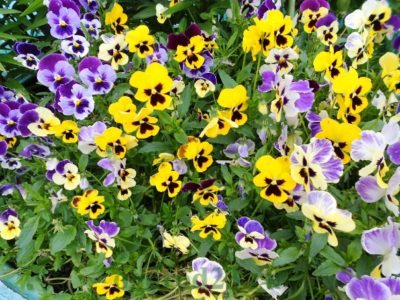

It is important to maintain the optimum temperature for the favorable growth of flowers. The seedlings should be planted in a room with a temperature of 17-18 degrees. After the first shoots appear, you need to lower the temperature to 13 degrees.
You need to adhere to a certain distance between seedlings, namely 10-20 cm... If you do not keep the distance between the seedlings, rotting of the plant roots may begin.

